Kristine Hughes's Blog, page 58
June 19, 2016
ON THE SHELF: THE MITFORDS - LETTERS BETWEEN SIX SISTERS
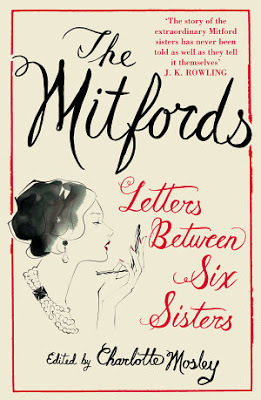
I had bought this large (800+ pp) volume at Hatchard's on my trip to London in 2014 and had first tried to read it when it finally arrived in a Royal Mail bag, along with several other books. I made it through the first chapter before realizing that I was thoroughly lost - who in the world is Honks? Which sister was called Woman? And who is The French Lady, as there were two sisters who lived in France? At that time, I had scant knowledge of the biographies and inner workings of the Mitford Sisters. Thus, I've spen the past year attempting to rectify that deficit, not simply in order to be able to read this book, but because the Mitford sisters, their circle of family and friends, the times they lived through and much else about them is fascinating.
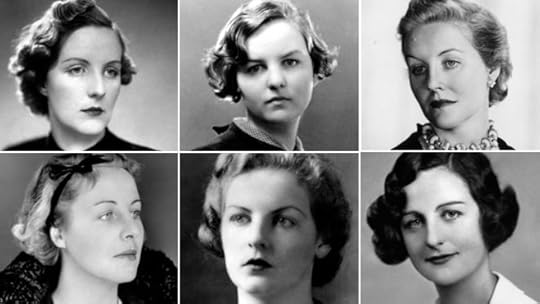 The Mitford sisters (clockwise from top left): Unity; Jessica; Diana; Nancy; Deborah; PamelaBelow are the thumbnail biographies for each sister, and their brother, from the Mitford Family entry in Wikipedia:
The Mitford sisters (clockwise from top left): Unity; Jessica; Diana; Nancy; Deborah; PamelaBelow are the thumbnail biographies for each sister, and their brother, from the Mitford Family entry in Wikipedia:Nancy Mitford (28 November 1904 – 30 June 1973). Married Peter Rodd and had a longstanding relationship with French politician and statesman Gaston Palewski. She lived in France much of her adult life. A writer of many novels, including her most popular (and somewhat autobiographical), The Pursuit of Love and Love in a Cold Climate . Also a noted biographer of historical figures, including the Sun King.Pamela Mitford (25 November 1907 – 12 April 1994). Known as "Woman." Married and divorced the millionaire physicist Derek Jackson. John Betjeman, who for a time was in love with her, referred to her as the "Rural Mitford". After her divorce, she spent the remainder of her life as the companion of Giuditta Tommasi (died 1993), an Italian horsewoman.Thomas Mitford (2 January 1909 – 30 March 1945), known as Tom was educated at Eton, a close friend of James Lees-Milne there. Lover of Tilly Losch during her marriage to Edward James. Died as a soldier in Burma. According to Jessica's letters, he supported British fascism and was stationed in Burma after refusing to fight in Europe.Diana Mitford (17 June 1910 – 11 August 2003). Married aristocrat and writer Bryan Walter Guinness in the 1929 society wedding of the year. She left him in the society scandal of the year (1933) for British fascist leader Sir Oswald Mosley. She was interned in Holloway Prison during the Second World War. Her belief in fascism never wavered nor her affection for Adolf Hitler. Mother of Max Mosley.Unity Valkyrie Mitford (8 August 1914 – 28 May 1948), "Bobo" or "Boud" to her siblings. Famous for her adulation of and friendship with Adolf Hitler. Shot herself in the head days after Britain declared war on Germany, but failed to kill herself and eventually died of pneumococcal meningitis at West Highland Cottage Hospital, Oban, after being transferred from Inch Kenneth.Jessica Mitford (11 September 1917 – 22 July 1996), commonly known as "Decca". Eloped with Esmond Romilly to the Spanish Civil War. Spent most of her adult life in the United States. Two years after Esmond was killed during the Second World War she married Robert Treuhaft, whom she met as a fellow US government employee. Member of the American Communist Party until 1958. She wrote several volumes of memoirs and several volumes of polemical investigation, including the best-selling The American Way of Death (1963) about the funeral industry. Grandmother of James Forman, Jr. and Chaka Forman, sons of the African-American civil rights leaderJames Forman by her daughter Constancia Romilly.Deborah Mitford (31 March 1920 – 24 September 2014). Married Andrew Cavendish who became the Duke of Devonshire, and with him turned his ancestral home,Chatsworth House, into one of Britain's most successful stately homes. She wrote a dozen books.
To read more on the Sisters, click here to find a 2014 article on them from the BBC Magazine. I won't give you my personal opinion on each sister, as I don't want you to be influenced before you read the book yourself.
Letters Between Six Sisters was edited by Charlotte Mosley, who is married to Max Mosley, son of Diana Mitford. She has done a marvelous job here and managed to organize a monumental amount of material into a cohesive and very readable format. As the Editor's Note tells us from the start, "the correspondence between the six Mitford sisters consists of some twelve thousand letters - of which little more than five per cent has been included in this volume." The letters begin in 1925 with a single letter from Pamela to Diana and pick up speed in the early 1930's. Mosley thankfully prefaces each decade with an overview of what was occurring in the lives of each sister during that time. Naturally, the elephant in the room for the Mitfords during the 1930's was Unity's passion for Adolph Hitler. One never gets a clear picture of Unity as a person, in this or any other source, so I still can't decide whether her Nazi fantaticism was down to Unity's having been simple minded, cruel, impressionable or just plain mad. Unity stalked Hitler, especially in a restaurant he was known to frequent, and made no bones about these activities. In a letter to Diana in December of 1935, Unity wrote: " . . . today at last he came, it was wonderful, and he was tremendously surprised to see me. He immediately asked me . . . to go and sit with him . . . The Fuhrer was heavenly, in his best mood, and very gay. There was a choice of two soups and he tossed a coin to see which one he would have, and he was so sweet doing it. He asked after you, and I told him you were coming soon. He talked a lot about Jews, which was lovely. News from Absyssinia and Egypt kept on coming through on the telephone, which was rather exciting. The Furher stayed in the Osteria for two hours, wasn't it lovely . . . . ." She signed the letter "With best love and Heil Hitler! Bobo."
Of course, the letters can only tell us so much about any aspect of the Sister's lives. Their individual feelings about any subject, or about each other, at various points over the years were often not consigned to writing. There is a lot of reading between the lines to be done, which Mosley admirably accomplishes. However, not all is as it seems, even with her help. In June of 1940, Diana Mitford and her husband, Facist leader Oswald Mosley, were both jailed without charge or trial under Defense Regulation 18B, which allowed for the internment of people suspected of being Nazi sympathisers during WWII. Diana was remanded to Holloway Prison. This did not stop the Sisters from communicating. On 19 November of 1941, Deborah suffered the death of her newborn child, a boy who had been born prematurely, and wrote to Diana in prison: "It was heaven of you to write your precious letter and all. You can't think how much better I feel now, really quite alright. . . Oh Honks, never Gilliat again, I have completely lost confidence in him. He never turned up till ages after he was wanted and when I was there with everything over he came in and the nurses said `Here's a friend to see you' and if I'd had the strength I really would have kicked him or at least asked him where he had been all the afternoon . . . . " Three days later, on 22 November 1941 Nancy also wrote to Diana from her own hospital bed in London, "Darling Diana - Thanks so much for the wonderful grapes, you really are an angel and grapes are so good for me. I have had a terrible time, so depressing because they had to take out both my tubes and therefore I can never now have a child. I can't say I suffered great agony but quite enough discomfort . . . . The Rodds (Nancy's soon to be ex inlaws) have been wonderfully true to form - my mother in law was told by the surgeon I shld be in danger for 3 days, and not one of them even rang up to enquire let alone sending a bloom or anything. I long to know if they bothered to look under R in the deaths column, very much doubt it however. . . Muv (their mother) was wonderful, she swam in a haze of bewilderment between me and Debo. When my symptoms were explained to her she said 'ovaries - I thought one had 700 like caviar.' Then I said how I couldn't bear the idea of a great scar on my tum to which she replied `But darling whose ever going to see it?' . . . . Much love darling and many more thanks for the grapes, Nancy."
On the face of it, both of these letters sound like nothing more than correspondence from two sisters to a third. Nancy's letters, though written from a hospital bed, still manage to retain Nancy's typical breezy tone, offered up with a dollop of sarcasm. However, in 2002, MI5 released WWII era documents that described Lady Mosley (Diana Mitford) and her political leanings. "Diana Mosley, wife of Sir Oswald Mosley, is reported on the 'best authority', that of her family and intimate circle, to be a public danger at the present time. Is said to be far cleverer and more dangerouso than her husband and will stick at nothing to achieve her ambitions. She is wildly ambitious." Nancy Mitford was the `best authority' quoted above. Diana at last learned that her sister had not once but twice written to the government about herself and Oswald Mosley and that her words had gone a long way towards seeing them both imprisoned.
These two dark episodes in the lives of the Mitford Sisters aside, the majority of the letters in this book are far lighter in tone. Here are a few examples:
Deborah to Diana, 13 August 1957 - " . . . . I wonder if you've seen the papers, they are full of Hardwick and the death duty deals, I think v. satisfactory for us but sad nevertheless (1). . . . Evelyn Waugh came last week, on his way to Renishaw. He is a crusty old thing, he didn't actually get cross but one felt he was on the verge all the time. The Wife was here (2), we were talking in my room when we'd mounted (the stairs) and he kept coming in saying things like `I hope there is Malvern Water by my bed, I hope the blinds keep the light out, may I have some lemonade to take my sleeping draught in, has Lady Mersey finished with the bathroom' and generally making one feel that things weren't quite right and that it was one's fault. I thought he had really gone for good when he came back with a look of triumph on his face, and said `I've looked in the pedestal beside my bed and I thought I ought to tell you the POT IS FULL.' Oh Honks the humiliation, the horror. I was rooted to the bed, couldn't help in any way, left him and the Wife to deal with it, hid my head in the blankets and was properly put out. Evelyn seemed rather pleased. Oh dear, not what Nancy calls a nice character . . . "
1. Hardwick Hall, which had been in the Devonshire family for fifteen generations, and nine of Chatsworth's most important works of art, had been handed over to the government in lieu of death duties.
2. Lady Mersey, Deborah's longtime friend.
Deborah to Diana, 13 August 1958 " . . . . . We went to lunch with the Sitwells on Monday. Dame Edith was in a long fur coat (which she never even unbuttoned for lunch) and a feather hat and her long white hands and huge rings. She is lovely and gone on the same people as me, viz. Cake (1) and Greta Garbo. She told us the chief things she remembered her mother saying were 'We must remember to order enough quails for the dance' and 'If only I could get your Father put into a lunatic asylum.' Poor Osbert doesn't seem much worse, but it is frightening to see him walk with that fast shuffle . . . . . "
(1) The Queen Mother. Deborah adopted the nickname after attending a wedding where the Queen Mother, when told that the bride and groom were about to cut the cake, exclaimed, 'Oh, the cake!' as though she had never seen it happen before. Deborah was lastingly impressed by her enthusiasm.
Nancy to Pamela, 25 November 1966 - "Dereling, Many Happies - but where to send them? Oi don't know. How old we are, eet ees deesgusting - I wonder if we smell like old people used to. One lars (alas). 28 Nov 66 Well I left this to moulder and got yours this mg from a very improbably address but also one from Debo expecting you there. The list! (1) Diana and I are already on non-speakers over it but finally arranged for her to fetch the things (all that either you or the others don't want) and then will fight it out here. But be sure to take what you do want regardless of us. I die specially for the opal brooch and the Miss Mitford watch. If Debo begins to say she wants anything kindly direct her gaze to the Chatsworth Safe and say I said so. Take her there and shut the door on her until the things are in Forceful Lady Mosley's bag. (Though Lady M is putty in her hands I fear.) I've got to do a thing on the Fr. wireless and must flee - Much love, Naunceling.
(1) A list of possessions belonging to the sisters' Aunt Iris, who had recently died.
The final letter was sent by fax from Deborah to Diana on 5 January, 2002 and runs "Darling Honks - So thrilled with two from you this a.m. Keep at it but please make the ghoul effort and finish yr book for OUR SAKES. I've just written you a long letter but this is to say we're still alive in the snow and cold THEY give a thaw but God seems to think otherwise in his unsweeting way. I wish he'd weet a bit. Hurrying over the ice to the post in the village. Much love, Debo."
On the whole, there is nothing earth shattering in any of the letters - they are simply missives between six sisters which give a rare insight into a way of life now gone and celebrated names long passed. But as a whole, the letters transport one into a world that was far more enchanting, amusing and engaging than the present day. At least for as long as it takes one to get through the 800 plus pages of this book. I am bereft having just finished it. Let's hope that Charlotte Mosley gets around to editing the other 95% of the Mitford sister's letters soon. In the meantime, I consoled myself by visiting two Mitford sites during my trip to England in May
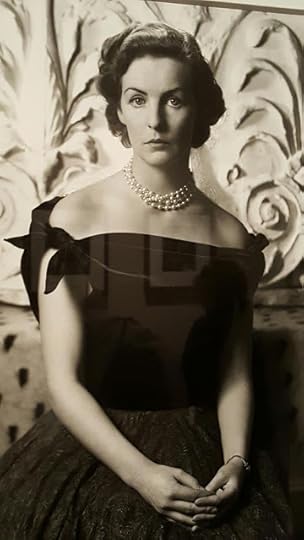
Chatsworth House
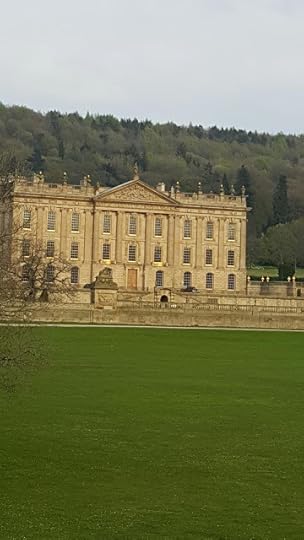
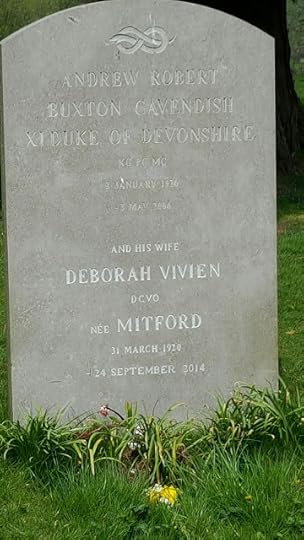
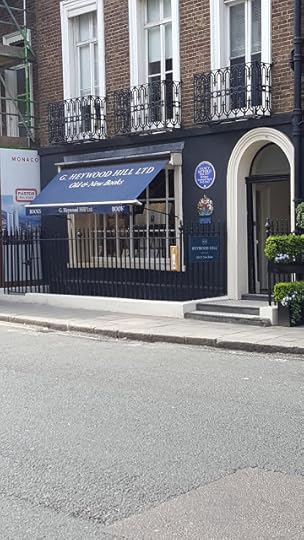
Heywood Hill Bookshop, Curzon Street
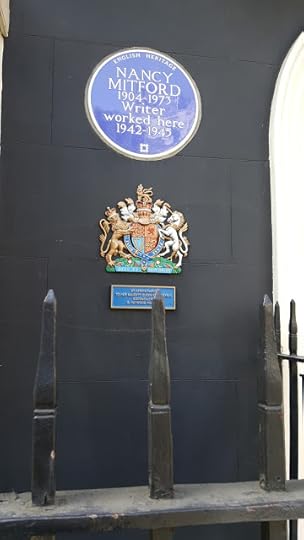
And in case you simply cannot get enough of the Mitfords, here's the link to the Mitford Society, which regularly posts new articles on the subject(s) and which offers a good sized archive of past articles.
Please click here to find a video of Charlotte Mosley interviewing Deborah, Duchess of Devonshire, for the Frick Collection.
Published on June 19, 2016 23:30
June 17, 2016
OPEN HOUSE 2014: THE ARGENTINE AMBASSADOR'S RESIDENCE IN BELGRAVIA
OPEN HOUSE 2014: THE ARGENTINE AMBASSADOR'S RESIDENCE IN BELGRAVIA
For those of you reading on-line novel Belgravia by Downton Abbey's Julian Fellowes, this will give you a few peeks at the neighborhood to supplement the material in the app.
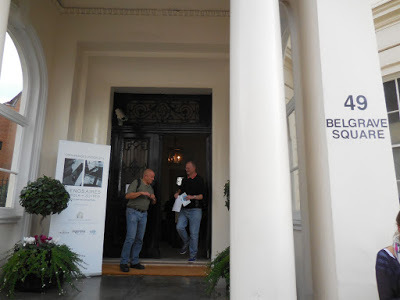 Entry of 49 Belgrave Square
Entry of 49 Belgrave Square
This was our last stop on Open City Sunday in September, 2014, and our Finale to the Pre- and Post-Duke of Wellington Tour. Victoria here, admitting that Kristine and I were about exhausted. In fact, beyond exhausted. But heck, we were in London and we couldn't pass up ANYTHING. So we took a taxi across town -- or actually, not very far, to Belgrave Square from Whitehall.
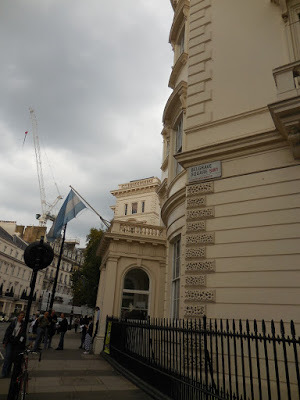
In Belgravia, the atmosphere is quite different. It is primarily a residential neighborhood, though rarely single-family homes, for which these buildings were created. A number of embassies, institutions and apartments are now found here, and the attractive mews, once the home of the horses, carriages and grooms of the Victorian and Edwardian eras, are now quaint houses and condos.
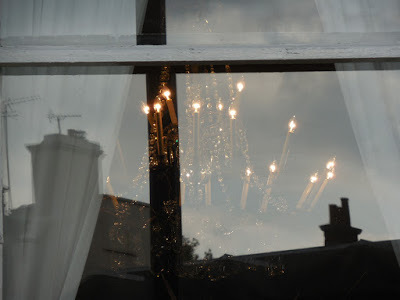
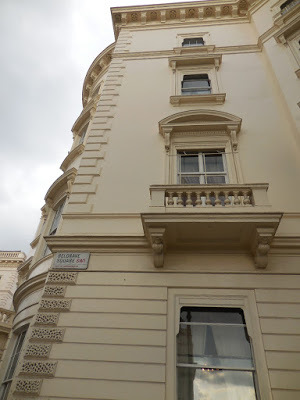
WE walked all around this particular house to see every angle...though sadly, no pictures were allowed in the elegant interior.
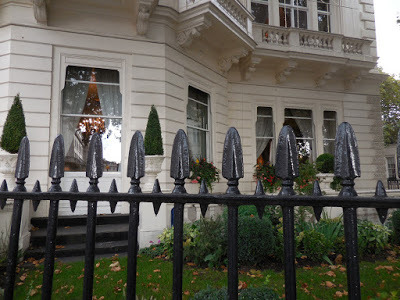
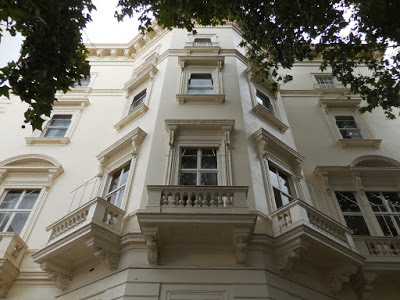
49 Belgrave Square was part of Thomas Cubitt's development of the area in the 1850's. The houses were designed for wealthy London residents, with ample space for large families, many servants, and space for entertaining.
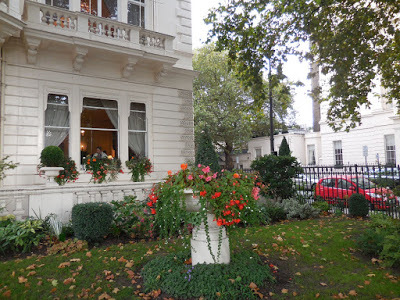
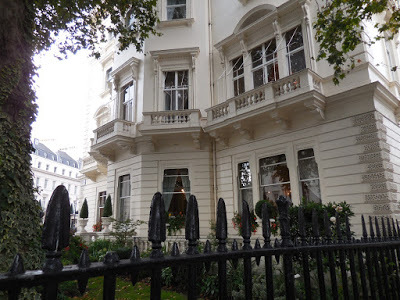
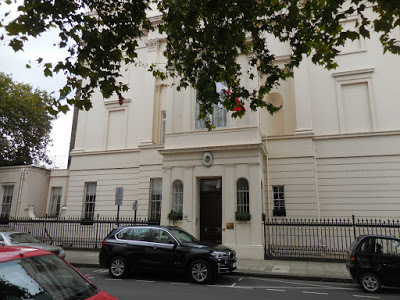
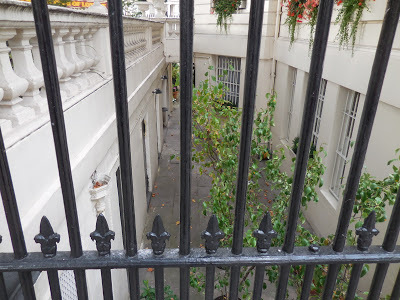
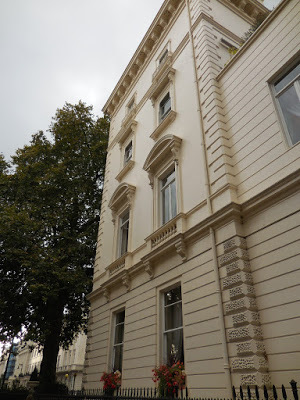
Wikipedia tells us it is a Grade II listed house, first owned by Sidney Herbert, 1st Baron Herbert of Lea, and later by the Duke of Richmond, then the Beit family.
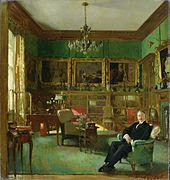 Sir Otto Beit in his study, 49 Belgrave Square by William Orpen, 1913, Johannesburg Art Gallery
Sir Otto Beit in his study, 49 Belgrave Square by William Orpen, 1913, Johannesburg Art Gallery
Wikipedia says, "The building was acquired by Argentina in 1936, and has since been used as their Ambassador's official London residence...In World War II, the house became a meeting place and haven for Argentines who volunteered in the British forces, mostly as pilots."
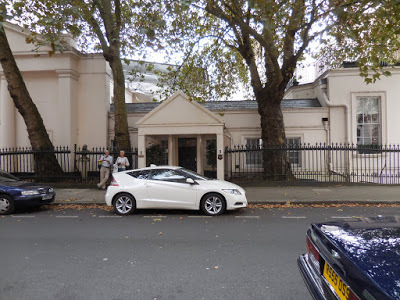
By now both Kristine and I had bluddy stubs for feet...and though we tried one more nearby club where the limited spaces had all been filled, we were satisfied with our day. One more flight of stairs and I would have sat down and sobbed.
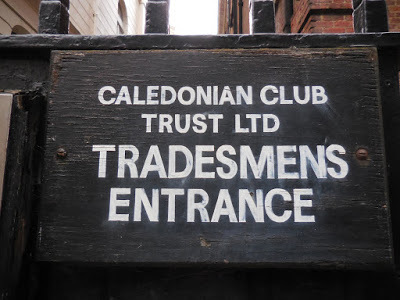 We couldn't even broach this entrance!
We couldn't even broach this entrance!
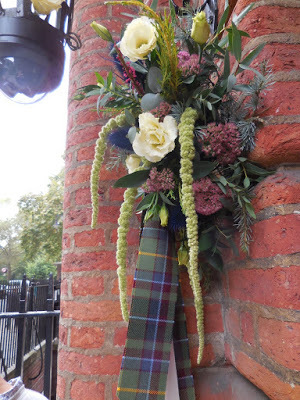 As close to getting inside the Caledonian Club as we came
As close to getting inside the Caledonian Club as we came
So, sated with all the sights we had enjoyed, we fumbled our way "home" to Hampstead, grabbed a bite of dinner, and sadly packed for our flights back to the States the next morning.
But, never fear, fellow travelers. Intrepid tour guide extraordinaire, Kristine herself, will be masterminding more tours in the near future. Watch this spot for further information and save your pennies, shillings, and pounds.
For those of you reading on-line novel Belgravia by Downton Abbey's Julian Fellowes, this will give you a few peeks at the neighborhood to supplement the material in the app.
 Entry of 49 Belgrave Square
Entry of 49 Belgrave SquareThis was our last stop on Open City Sunday in September, 2014, and our Finale to the Pre- and Post-Duke of Wellington Tour. Victoria here, admitting that Kristine and I were about exhausted. In fact, beyond exhausted. But heck, we were in London and we couldn't pass up ANYTHING. So we took a taxi across town -- or actually, not very far, to Belgrave Square from Whitehall.

In Belgravia, the atmosphere is quite different. It is primarily a residential neighborhood, though rarely single-family homes, for which these buildings were created. A number of embassies, institutions and apartments are now found here, and the attractive mews, once the home of the horses, carriages and grooms of the Victorian and Edwardian eras, are now quaint houses and condos.


WE walked all around this particular house to see every angle...though sadly, no pictures were allowed in the elegant interior.


49 Belgrave Square was part of Thomas Cubitt's development of the area in the 1850's. The houses were designed for wealthy London residents, with ample space for large families, many servants, and space for entertaining.





Wikipedia tells us it is a Grade II listed house, first owned by Sidney Herbert, 1st Baron Herbert of Lea, and later by the Duke of Richmond, then the Beit family.
 Sir Otto Beit in his study, 49 Belgrave Square by William Orpen, 1913, Johannesburg Art Gallery
Sir Otto Beit in his study, 49 Belgrave Square by William Orpen, 1913, Johannesburg Art GalleryWikipedia says, "The building was acquired by Argentina in 1936, and has since been used as their Ambassador's official London residence...In World War II, the house became a meeting place and haven for Argentines who volunteered in the British forces, mostly as pilots."

By now both Kristine and I had bluddy stubs for feet...and though we tried one more nearby club where the limited spaces had all been filled, we were satisfied with our day. One more flight of stairs and I would have sat down and sobbed.
 We couldn't even broach this entrance!
We couldn't even broach this entrance! As close to getting inside the Caledonian Club as we came
As close to getting inside the Caledonian Club as we cameSo, sated with all the sights we had enjoyed, we fumbled our way "home" to Hampstead, grabbed a bite of dinner, and sadly packed for our flights back to the States the next morning.
But, never fear, fellow travelers. Intrepid tour guide extraordinaire, Kristine herself, will be masterminding more tours in the near future. Watch this spot for further information and save your pennies, shillings, and pounds.
Published on June 17, 2016 00:00
June 14, 2016
ONCE AGAIN WEDNESDAY: A Day at the Library of Congress in Washington, D.C.
by Victoria Hinshaw - originally published on March 22, 2010
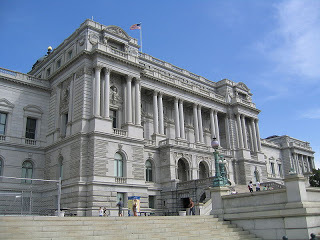 The LOC Jefferson Building
The LOC Jefferson Building
What could be more fulfilling (at least on this side of the Atlantic) than a day doing research at the Library of Congress (LOC) in Washington, D.C.? I recently had such a lovely day that I want to share my fun with everyone. Sitting at a desk in the elegant Jefferson Reading Room is a great privilege.
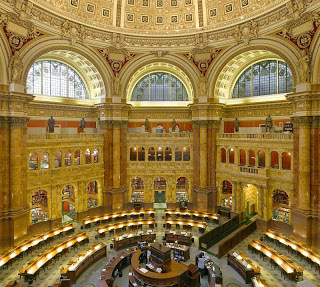 Jefferson Building, Main Reading Room
Jefferson Building, Main Reading Room
The first step is to secure a Reader's Card, for which you must bypass the Victorian elegance of the Jefferson Building for the sober functionalism of the Madison Building across Independence Avenue SE. When you present your picture identification (driver’s license or passport) you will be issued a card which admits you to the reading rooms, of which there are many for various purposes. If you go, be aware that all your possessions will be scanned at each entrance and all bags, purses and briefcases checked at the door (you can take your wallet, notebooks, etc. into the reading rooms). The researcher’s entrance into the Jefferson building is located at the corner of 2nd and Independence SE. No admission to the reading rooms is available from the other public entrances, but there is a viewing area above. All information on opening hours, rules, and regulations are on the LOC website.
The LOC is the largest library in the world. It was established about 1800 as a service for members of Congress, government officials, and the American public. Books cannot be checked out except by the first two groups or through OCLC interlibrary loan. However, the LOC is very available on the internet; you can spend hours exploring their site.
I had used the on-line catalogue to find the call numbers of the books I wanted and they were delivered to my desk quickly. While I waited for them, I found some useful materials in the open stacks of the reference collection. I became very absorbed in the content of my choices, so much so that I really did not spend as much time people-watching as I had expected. Over all, however, I would say that the patrons as well as the librarians represented a rather ordinary cross-section of the population.
Among the books I consulted were the six volumes by John Cam Hobhouse, Lord Broughton, Recollections of a Long Life; works by and about Horace Walpole, and The Diary of Lady Mary Clavering Cowper, Lady of the Bedchamber to the Princess of Wales, 1716-1720. Any one of my references could have occupied me for a full day.
Just so you know, there is a snack bar and a cafeteria available a short hike away. After lunch, I decided to consult the digital newspaper files and was able to conduct a search and access many articles from 18th and 19th century London newspapers. In this effort I was considerably aided by one of the librarians who helped me through the links to find the search engines and newspapers.
Many of the library’s services are available on line from any computer. There may be some charges involved for certain activities, but that will vary by the subject and purpose. For full instructions, consult the website. And don’t hesitate to try the Ask a Librarian section.
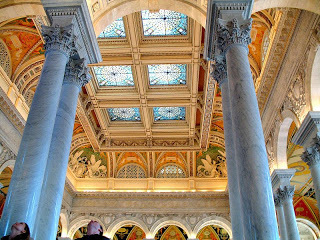 In the Great Hall, Jefferson Building
In the Great Hall, Jefferson Building
There are many advantages to working at the LOC in person. Primarily, I loved the ambience, the hushed sounds of papers rustling and whispered conversations in the reading room, the tap of my shoes on the old marble floors, even the weight of the heavy wooden doors. The buildings are fascinating, particularly the Great Hall, with its flamboyant Italianate decoration. On view for the public are many changing
exhibitions on a variety of topics. The big disadvantage – to your purse – is a wonderful gift shop with a bountiful offering of tempting items. Of course, they too are available on line.
Although I have been there many times (I actually lived in Washington for a few years), I can't wait to go back. If you have a story about the LOC to share, please add it to Comments.
 The LOC Jefferson Building
The LOC Jefferson BuildingWhat could be more fulfilling (at least on this side of the Atlantic) than a day doing research at the Library of Congress (LOC) in Washington, D.C.? I recently had such a lovely day that I want to share my fun with everyone. Sitting at a desk in the elegant Jefferson Reading Room is a great privilege.
 Jefferson Building, Main Reading Room
Jefferson Building, Main Reading RoomThe first step is to secure a Reader's Card, for which you must bypass the Victorian elegance of the Jefferson Building for the sober functionalism of the Madison Building across Independence Avenue SE. When you present your picture identification (driver’s license or passport) you will be issued a card which admits you to the reading rooms, of which there are many for various purposes. If you go, be aware that all your possessions will be scanned at each entrance and all bags, purses and briefcases checked at the door (you can take your wallet, notebooks, etc. into the reading rooms). The researcher’s entrance into the Jefferson building is located at the corner of 2nd and Independence SE. No admission to the reading rooms is available from the other public entrances, but there is a viewing area above. All information on opening hours, rules, and regulations are on the LOC website.
The LOC is the largest library in the world. It was established about 1800 as a service for members of Congress, government officials, and the American public. Books cannot be checked out except by the first two groups or through OCLC interlibrary loan. However, the LOC is very available on the internet; you can spend hours exploring their site.
I had used the on-line catalogue to find the call numbers of the books I wanted and they were delivered to my desk quickly. While I waited for them, I found some useful materials in the open stacks of the reference collection. I became very absorbed in the content of my choices, so much so that I really did not spend as much time people-watching as I had expected. Over all, however, I would say that the patrons as well as the librarians represented a rather ordinary cross-section of the population.
Among the books I consulted were the six volumes by John Cam Hobhouse, Lord Broughton, Recollections of a Long Life; works by and about Horace Walpole, and The Diary of Lady Mary Clavering Cowper, Lady of the Bedchamber to the Princess of Wales, 1716-1720. Any one of my references could have occupied me for a full day.
Just so you know, there is a snack bar and a cafeteria available a short hike away. After lunch, I decided to consult the digital newspaper files and was able to conduct a search and access many articles from 18th and 19th century London newspapers. In this effort I was considerably aided by one of the librarians who helped me through the links to find the search engines and newspapers.
Many of the library’s services are available on line from any computer. There may be some charges involved for certain activities, but that will vary by the subject and purpose. For full instructions, consult the website. And don’t hesitate to try the Ask a Librarian section.
 In the Great Hall, Jefferson Building
In the Great Hall, Jefferson BuildingThere are many advantages to working at the LOC in person. Primarily, I loved the ambience, the hushed sounds of papers rustling and whispered conversations in the reading room, the tap of my shoes on the old marble floors, even the weight of the heavy wooden doors. The buildings are fascinating, particularly the Great Hall, with its flamboyant Italianate decoration. On view for the public are many changing
exhibitions on a variety of topics. The big disadvantage – to your purse – is a wonderful gift shop with a bountiful offering of tempting items. Of course, they too are available on line.
Although I have been there many times (I actually lived in Washington for a few years), I can't wait to go back. If you have a story about the LOC to share, please add it to Comments.
Published on June 14, 2016 23:30
June 13, 2016
WHAT KRISTINE SAW ON THE CAB RIDE TO BELGRAVE SQUARE
Published on June 13, 2016 00:00
June 10, 2016
OPEN HOUSE: THE FOREIGN OFFICE
OPEN HOUSE DAYS: THE FOREIGN AND COMMONWEALTH OFFICE, SEPTEMBER, 2014
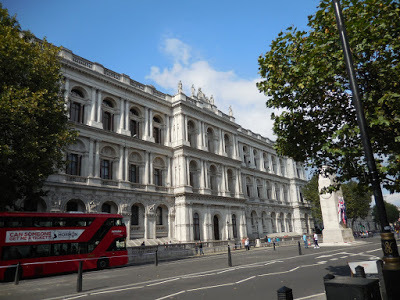 This vast building on Whitehall contains many architectural and decorative treasures, probably far more than we got to see. But perhaps that was a good thing, since so much tends to make one's eyes glaze over. The building (FCO) is headed by the Secretary of Foreign and Commonwealth Affairs, who sits in the Cabinet. The building, designed by George Gilbert Scott, was completed in 1868; it formerly housed four separate departments: the Foreign Office, The India Office, the Colonial Office, and the Home Office.
This vast building on Whitehall contains many architectural and decorative treasures, probably far more than we got to see. But perhaps that was a good thing, since so much tends to make one's eyes glaze over. The building (FCO) is headed by the Secretary of Foreign and Commonwealth Affairs, who sits in the Cabinet. The building, designed by George Gilbert Scott, was completed in 1868; it formerly housed four separate departments: the Foreign Office, The India Office, the Colonial Office, and the Home Office.
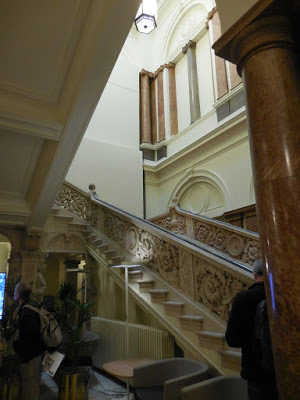 We did not have a long wait in line before we entered, part of a throng as eager as we were to see what was inside. The stairway was stunning.
We did not have a long wait in line before we entered, part of a throng as eager as we were to see what was inside. The stairway was stunning.
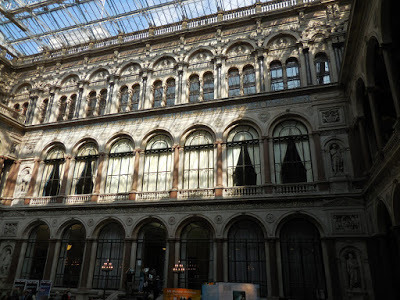 Our first major stop was the Durbar Court, center of the old India Department. The interior of this section of the building was designed by Matthew Digby Wyatt who followed themes of the British in India.
Our first major stop was the Durbar Court, center of the old India Department. The interior of this section of the building was designed by Matthew Digby Wyatt who followed themes of the British in India.
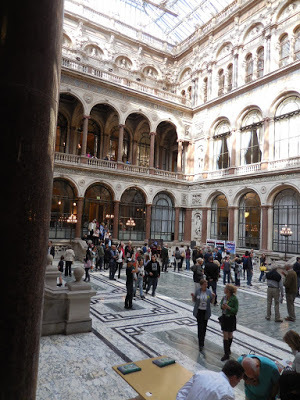
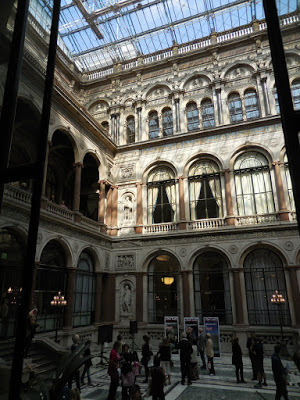
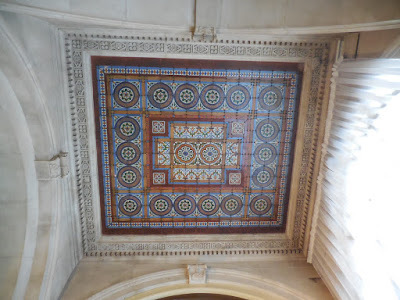
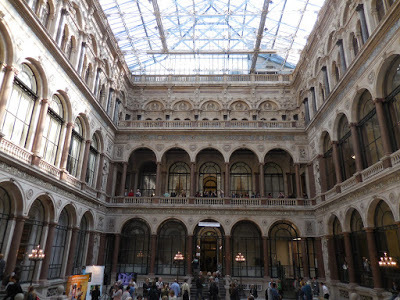 The Durbar Court was so named in 1902 when the coronation "Durbar" of King Edward VII was held there. According to a text panel, "Durbur" is an Indian word meaning court or formal ceremony.
The Durbar Court was so named in 1902 when the coronation "Durbar" of King Edward VII was held there. According to a text panel, "Durbur" is an Indian word meaning court or formal ceremony.
 We had to keep reminding ourselves to look downward to appreciate the fantastic floor designs.
We had to keep reminding ourselves to look downward to appreciate the fantastic floor designs.
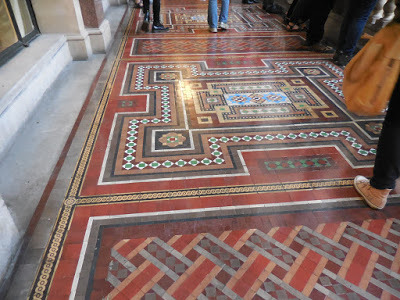
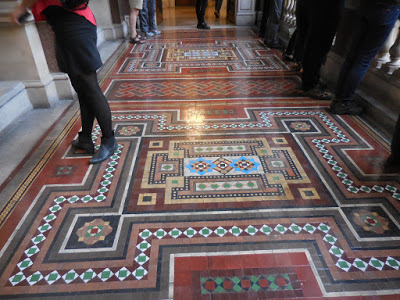
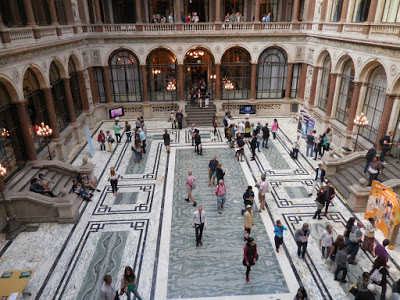
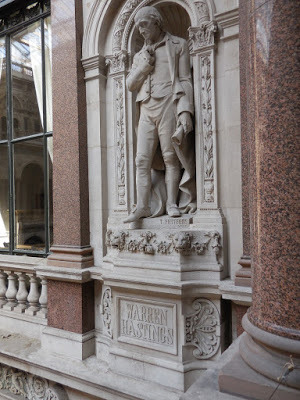 One of many statues, this of Warren Hastings (1732-1818), who was Governor General of India 1773-1785.
One of many statues, this of Warren Hastings (1732-1818), who was Governor General of India 1773-1785.
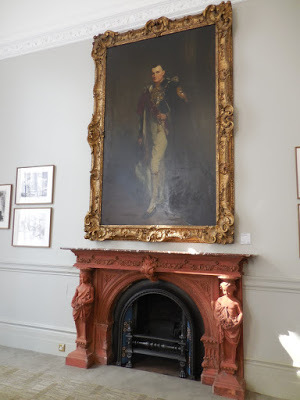 Edward Grey, 1st Viscount Grey of Falloden (1862-1933), Foreign Secretary
Edward Grey, 1st Viscount Grey of Falloden (1862-1933), Foreign Secretary
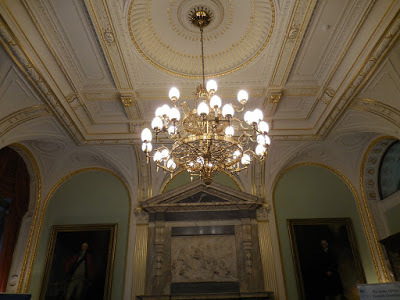
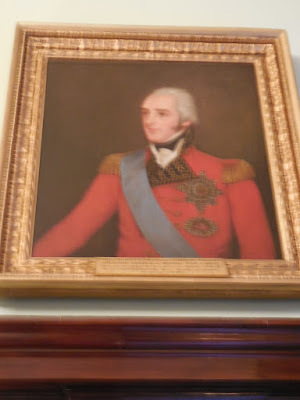 The Marquess of Wellesley (1760-1842), Governor General of India, 1797-1905
The Marquess of Wellesley (1760-1842), Governor General of India, 1797-1905
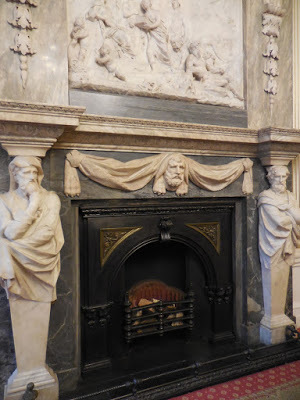
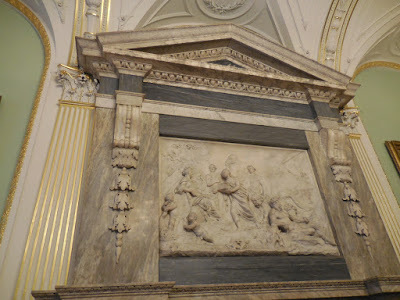
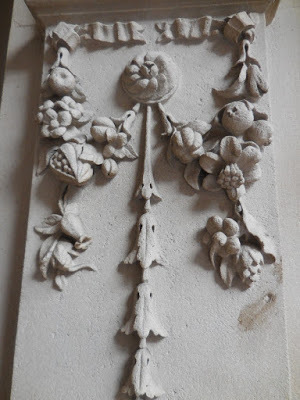
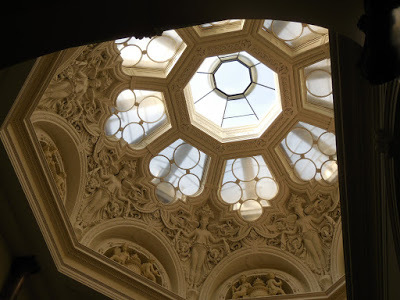
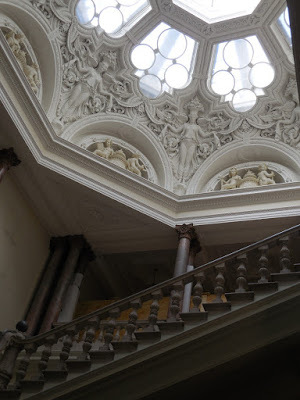
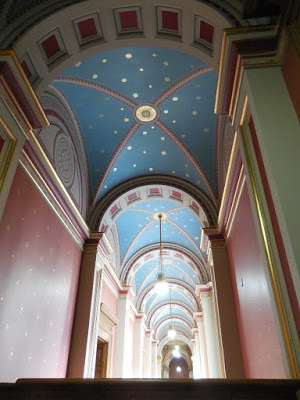
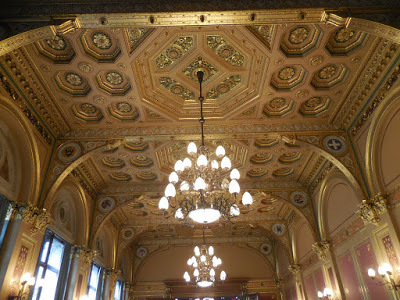 The Lucarno Conference Room
The Lucarno Conference Room
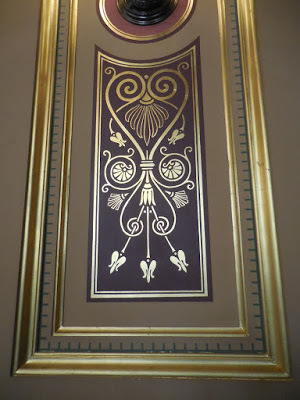
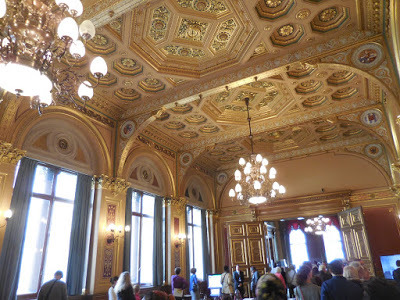 The Locarno Conference Room
The Locarno Conference Room
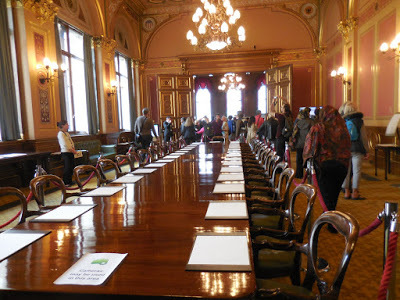 The FCO hosted the signing of the Locarno Treaties on European peace in 1925. These rooms were the scene of the formal ceremonies, many conferences, and diplomatic dinners.
The FCO hosted the signing of the Locarno Treaties on European peace in 1925. These rooms were the scene of the formal ceremonies, many conferences, and diplomatic dinners.
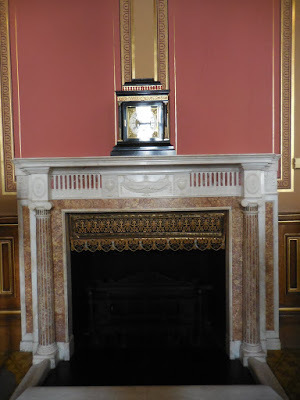 The elaborate Victorian interiors were restored from 1988 to 1992; the rooms are used for staff functions and diplomatic events.
The elaborate Victorian interiors were restored from 1988 to 1992; the rooms are used for staff functions and diplomatic events.
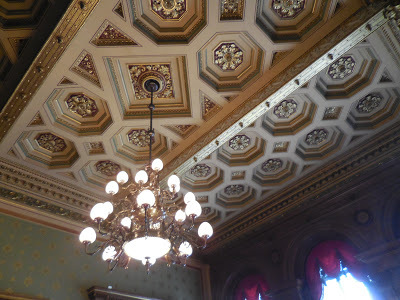 The Locarno Dining Room
The Locarno Dining Room
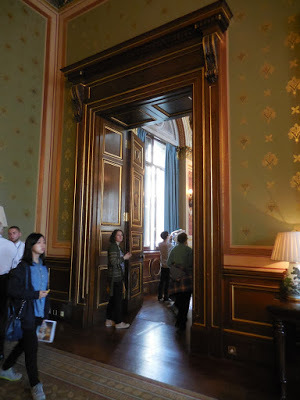
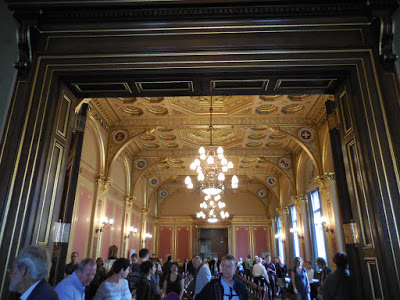
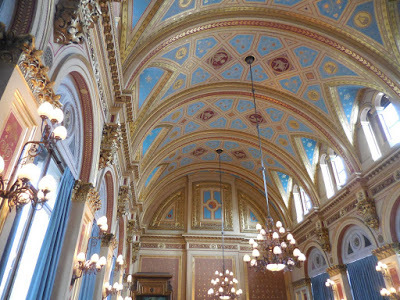
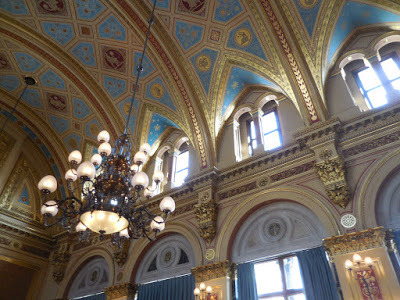
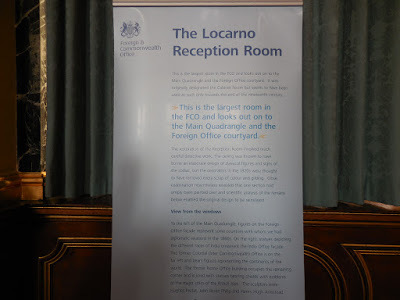
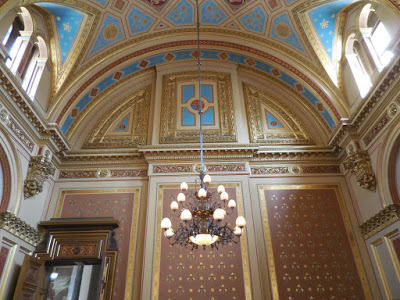 The ceilings and walls are exquisite.
The ceilings and walls are exquisite.
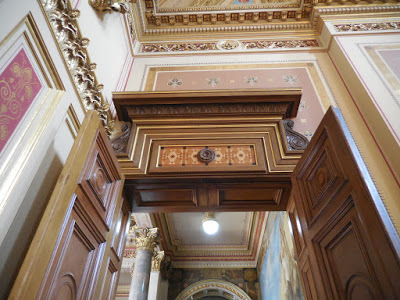
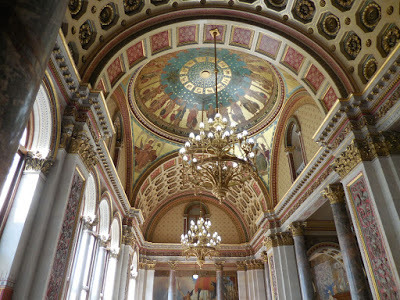
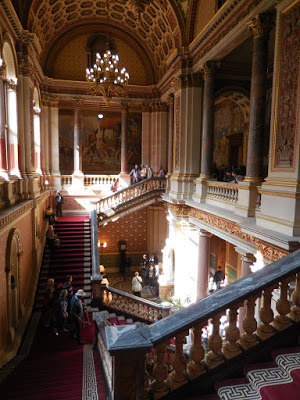 The Grand Staircase
The Grand Staircase
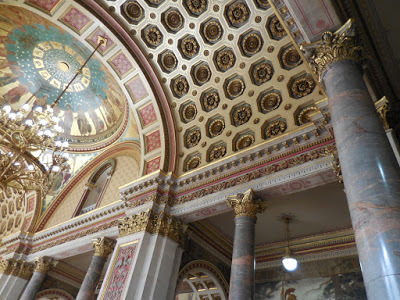
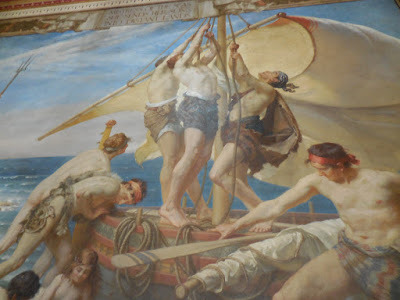 One of the Goetze murals, depicting the development and triumph of the British Empire.
One of the Goetze murals, depicting the development and triumph of the British Empire.
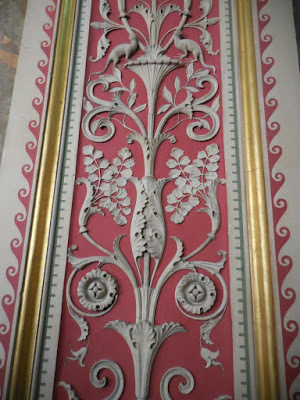 Wall panels
Wall panels
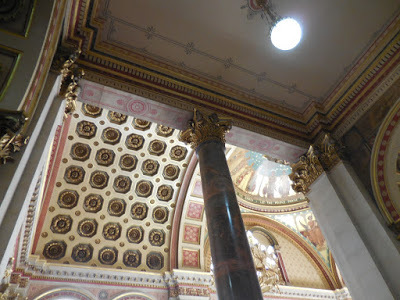
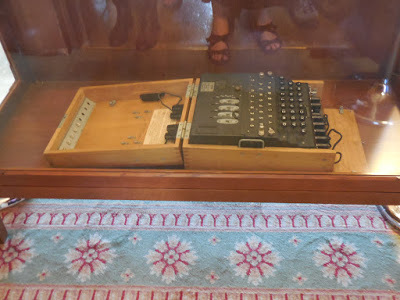 During World War II, these areas were covered with temporary panels and much of the work to decipher Nazi signals took place here, the Enigma project.
During World War II, these areas were covered with temporary panels and much of the work to decipher Nazi signals took place here, the Enigma project.
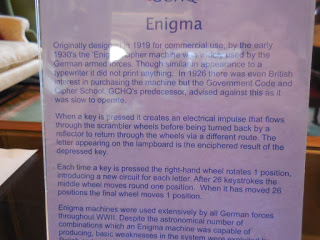
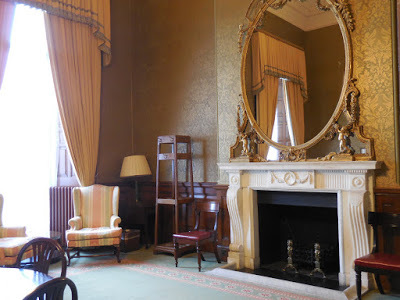
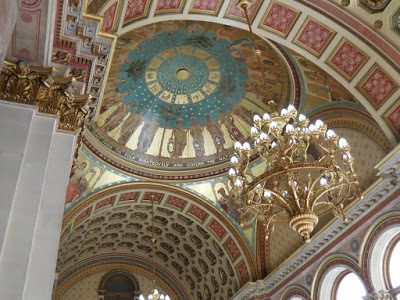 In the 1960's, proposals to demolish the FCO and replace it with a contemporary structure were considered, and fortunately, discarded in favor of restoration and listing as a Grade I protected site.
In the 1960's, proposals to demolish the FCO and replace it with a contemporary structure were considered, and fortunately, discarded in favor of restoration and listing as a Grade I protected site.
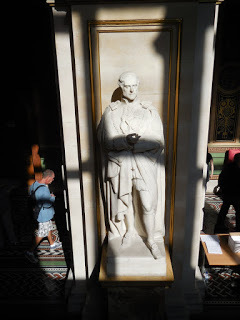
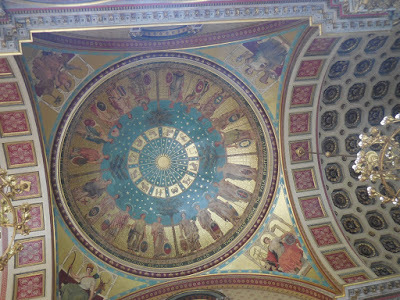
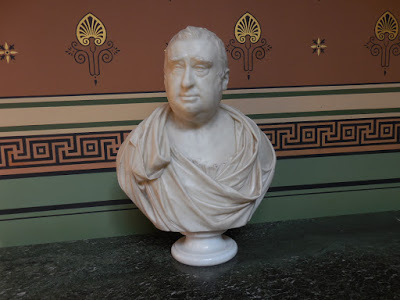 Charles James Fox (1749-1806) was the first Foreign Secretary, appointed in 1782, much to the disgust of King George III, who despised Fox and all his Whig cohorts.
Charles James Fox (1749-1806) was the first Foreign Secretary, appointed in 1782, much to the disgust of King George III, who despised Fox and all his Whig cohorts.
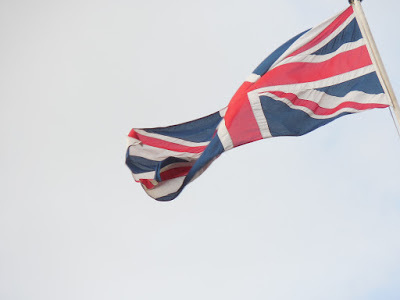
OPEN HOUSE WEEKEND IN 2016 IS SEPTEMBER 17 AND 18.
 This vast building on Whitehall contains many architectural and decorative treasures, probably far more than we got to see. But perhaps that was a good thing, since so much tends to make one's eyes glaze over. The building (FCO) is headed by the Secretary of Foreign and Commonwealth Affairs, who sits in the Cabinet. The building, designed by George Gilbert Scott, was completed in 1868; it formerly housed four separate departments: the Foreign Office, The India Office, the Colonial Office, and the Home Office.
This vast building on Whitehall contains many architectural and decorative treasures, probably far more than we got to see. But perhaps that was a good thing, since so much tends to make one's eyes glaze over. The building (FCO) is headed by the Secretary of Foreign and Commonwealth Affairs, who sits in the Cabinet. The building, designed by George Gilbert Scott, was completed in 1868; it formerly housed four separate departments: the Foreign Office, The India Office, the Colonial Office, and the Home Office.  We did not have a long wait in line before we entered, part of a throng as eager as we were to see what was inside. The stairway was stunning.
We did not have a long wait in line before we entered, part of a throng as eager as we were to see what was inside. The stairway was stunning. Our first major stop was the Durbar Court, center of the old India Department. The interior of this section of the building was designed by Matthew Digby Wyatt who followed themes of the British in India.
Our first major stop was the Durbar Court, center of the old India Department. The interior of this section of the building was designed by Matthew Digby Wyatt who followed themes of the British in India.


 The Durbar Court was so named in 1902 when the coronation "Durbar" of King Edward VII was held there. According to a text panel, "Durbur" is an Indian word meaning court or formal ceremony.
The Durbar Court was so named in 1902 when the coronation "Durbar" of King Edward VII was held there. According to a text panel, "Durbur" is an Indian word meaning court or formal ceremony. We had to keep reminding ourselves to look downward to appreciate the fantastic floor designs.
We had to keep reminding ourselves to look downward to appreciate the fantastic floor designs.


 One of many statues, this of Warren Hastings (1732-1818), who was Governor General of India 1773-1785.
One of many statues, this of Warren Hastings (1732-1818), who was Governor General of India 1773-1785. Edward Grey, 1st Viscount Grey of Falloden (1862-1933), Foreign Secretary
Edward Grey, 1st Viscount Grey of Falloden (1862-1933), Foreign Secretary
 The Marquess of Wellesley (1760-1842), Governor General of India, 1797-1905
The Marquess of Wellesley (1760-1842), Governor General of India, 1797-1905





 The Lucarno Conference Room
The Lucarno Conference Room
 The Locarno Conference Room
The Locarno Conference Room The FCO hosted the signing of the Locarno Treaties on European peace in 1925. These rooms were the scene of the formal ceremonies, many conferences, and diplomatic dinners.
The FCO hosted the signing of the Locarno Treaties on European peace in 1925. These rooms were the scene of the formal ceremonies, many conferences, and diplomatic dinners.  The elaborate Victorian interiors were restored from 1988 to 1992; the rooms are used for staff functions and diplomatic events.
The elaborate Victorian interiors were restored from 1988 to 1992; the rooms are used for staff functions and diplomatic events. The Locarno Dining Room
The Locarno Dining Room




 The ceilings and walls are exquisite.
The ceilings and walls are exquisite.

 The Grand Staircase
The Grand Staircase
 One of the Goetze murals, depicting the development and triumph of the British Empire.
One of the Goetze murals, depicting the development and triumph of the British Empire. Wall panels
Wall panels
 During World War II, these areas were covered with temporary panels and much of the work to decipher Nazi signals took place here, the Enigma project.
During World War II, these areas were covered with temporary panels and much of the work to decipher Nazi signals took place here, the Enigma project.

 In the 1960's, proposals to demolish the FCO and replace it with a contemporary structure were considered, and fortunately, discarded in favor of restoration and listing as a Grade I protected site.
In the 1960's, proposals to demolish the FCO and replace it with a contemporary structure were considered, and fortunately, discarded in favor of restoration and listing as a Grade I protected site. 

 Charles James Fox (1749-1806) was the first Foreign Secretary, appointed in 1782, much to the disgust of King George III, who despised Fox and all his Whig cohorts.
Charles James Fox (1749-1806) was the first Foreign Secretary, appointed in 1782, much to the disgust of King George III, who despised Fox and all his Whig cohorts. 
OPEN HOUSE WEEKEND IN 2016 IS SEPTEMBER 17 AND 18.
Published on June 10, 2016 00:00
June 8, 2016
CELEBRATING JANE AUSTEN IN MINNEAPOLIS
Victoria here. On May 14 Sue Forgue and I enjoyed the Spring meeting of the Minnesota Region of JASNA at the historic Woman's Club of Minneapolis, where we presented our talk from the Louisville 2015 AGM "London High Society in Austen's Novels."
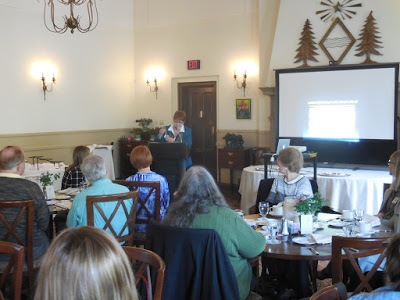 Above and Below, Minneapolis JASNA Regional Coordinator Candice Hern presides.
Above and Below, Minneapolis JASNA Regional Coordinator Candice Hern presides.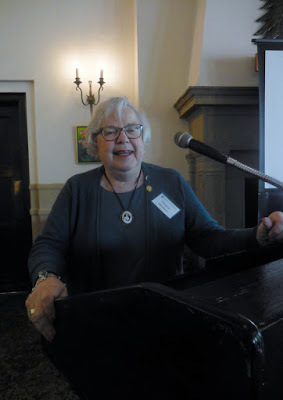 Later, Victoria posed at the lectern
Later, Victoria posed at the lectern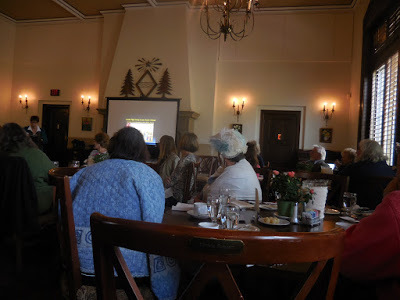
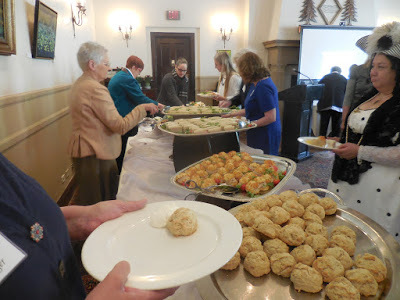 The tea/feast was scrumptious.
The tea/feast was scrumptious.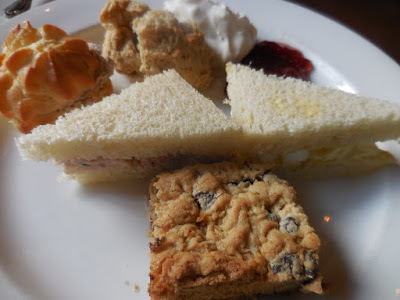
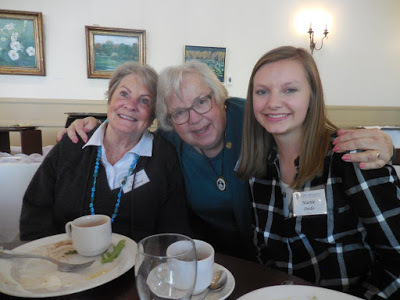 In attendance were my cousin Julie and her granddaughter Marnie.
In attendance were my cousin Julie and her granddaughter Marnie.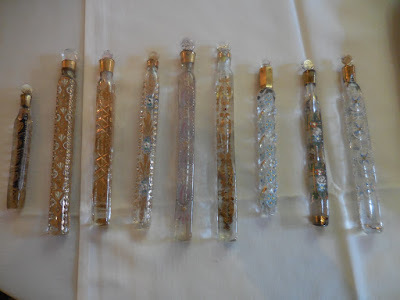 Candice charmed us with her exhibition of antique scent vials. These were used to hold samples of perfume and intended to be discarded. However, many have survived, probably due to their beauty and craftsmanship. More on Candice's Collections can be viewed on her outstanding website, here.
Candice charmed us with her exhibition of antique scent vials. These were used to hold samples of perfume and intended to be discarded. However, many have survived, probably due to their beauty and craftsmanship. More on Candice's Collections can be viewed on her outstanding website, here.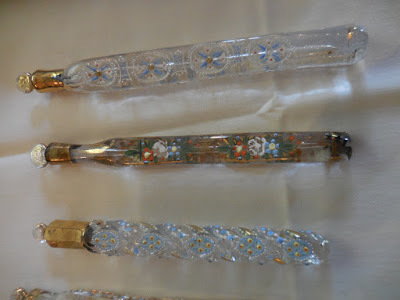
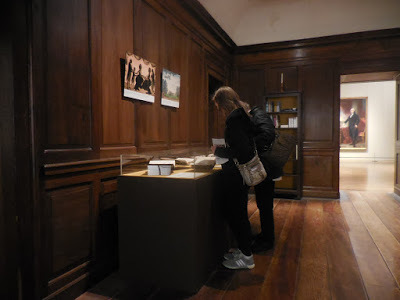 After the program, we drove over to the Minneapolis Institute of Art to see the Jane Austen Room.
After the program, we drove over to the Minneapolis Institute of Art to see the Jane Austen Room.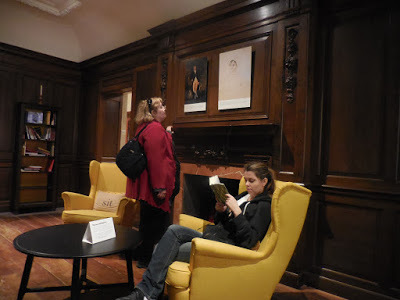 Actually, there were two rooms from the museum's collection of decorative arts. The paneled room was fitted as a library with exhibits and the books of Jane Austen and some of her comptemporaries for the reading pleasure of visitors. Here Sue Forgue reads the text panels above the fireplace while an unidentified young lady sits and reads.
Actually, there were two rooms from the museum's collection of decorative arts. The paneled room was fitted as a library with exhibits and the books of Jane Austen and some of her comptemporaries for the reading pleasure of visitors. Here Sue Forgue reads the text panels above the fireplace while an unidentified young lady sits and reads.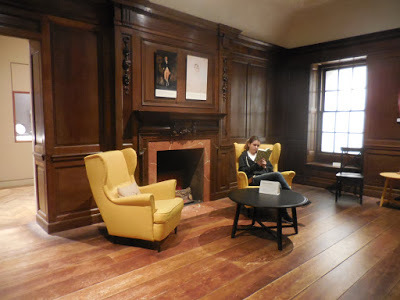
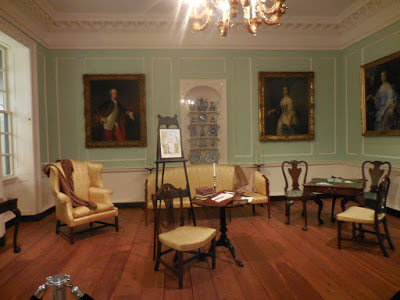 The main room was furnished as a drawing room from Emma Woodhouse's home, Hartfield.
The main room was furnished as a drawing room from Emma Woodhouse's home, Hartfield.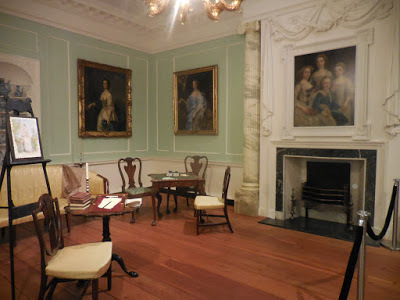 Not only were the furnishings perfect; there were also two special surprises portraying scenes from the novel Emma, this year celebrating its 200th anniversary.
Not only were the furnishings perfect; there were also two special surprises portraying scenes from the novel Emma, this year celebrating its 200th anniversary.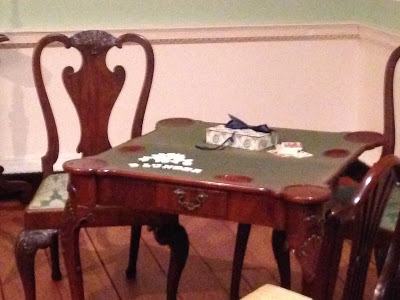 Above, a card table, showing the letter game from Emma in which the word is "blunder."Below, Emma's painting of Harriet Smith, by which Emma is hoping to interest Mr. Elton in her friend as a possible match. Thanks to Sue and her phone for these two close-up pictures.
Above, a card table, showing the letter game from Emma in which the word is "blunder."Below, Emma's painting of Harriet Smith, by which Emma is hoping to interest Mr. Elton in her friend as a possible match. Thanks to Sue and her phone for these two close-up pictures.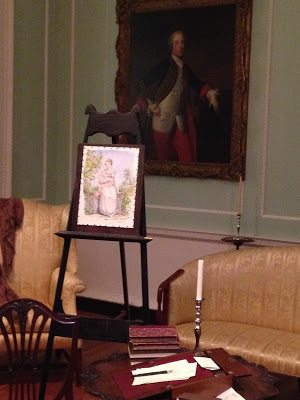
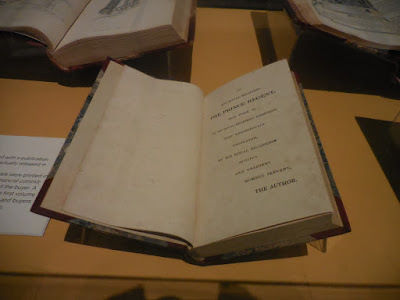 A first edition of Emma, 1816.
A first edition of Emma, 1816.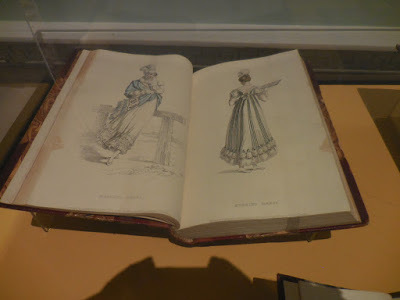 Fashion plates from an 1816 magazine.
Fashion plates from an 1816 magazine.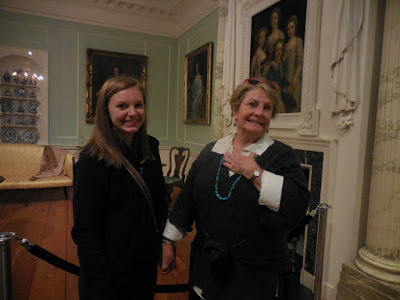 Marnie and Julie accompanied us to the MIA.
Marnie and Julie accompanied us to the MIA.The MIA website is here.
The Jane Austen Reading Rooms, on display through October 20, 2016, are here.
Published on June 08, 2016 00:30
June 6, 2016
WHAT KRISTINE AND VICTORIA SAW FROM THEIR SIDEWALK TABLE AT THE CLARENCE, WHITEHALL
Before we get to the sidewalk table, allow me to point out to you - as Victoria pointed out to me - that today's post is a milestone for us: Number One London's 1,500th Post! Unbelievable, and how fitting that today's post should deal with recurring subjects on this blog - Horse Guards, cocktails and visits to London. Weapons and police are new themes, but one has to take the good with the bad and with luck neither of these will have to be referred to by us again. And now to today's regularly scheduled post . . . . .
It was a warm day...and crowds filled the pavements in order to visit buildings during Open House London, a real treat, during which public and private structures that are usually closed to the public freely welcome visitors on a weekend each autumn. Join us now as we break for reviving cocktails at a sidewalk table at The Clarence in Whitehall, diagonally opposite Horseguards.

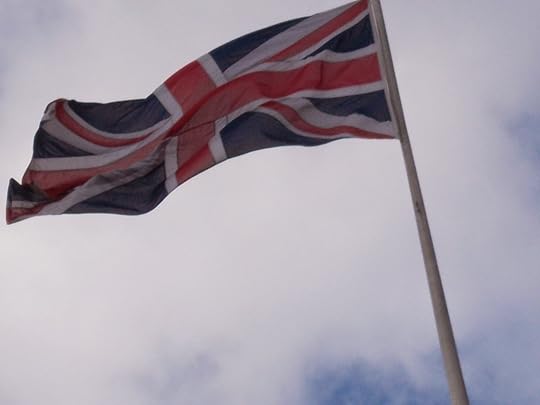

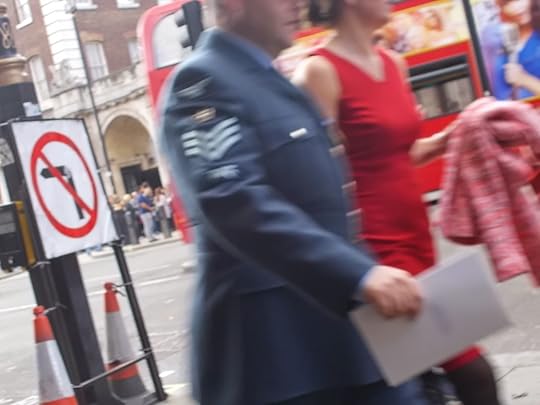
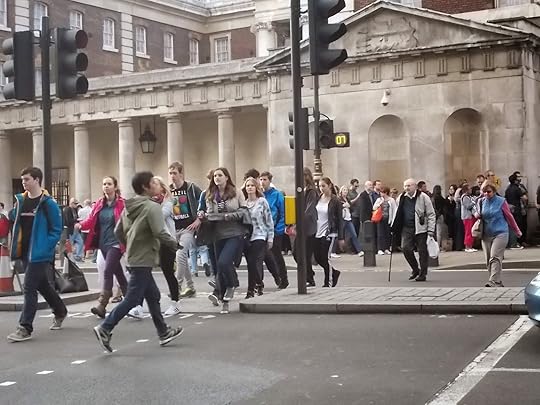
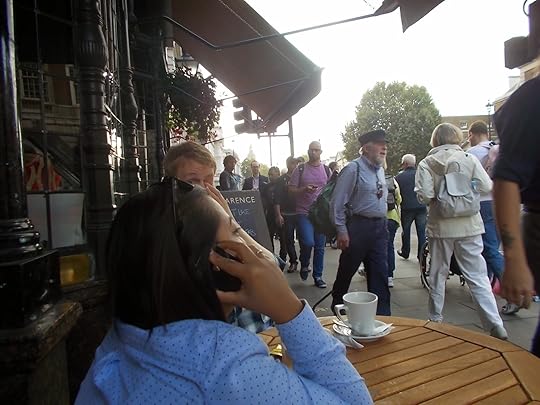
To say that sitting outside the Clarence puts one in the thick of things is a bit of an understatement, as these photos demonstrate. However, it's a grand place from which to people watch and we enjoyed the break - until a mob of protestors arrived en masse, as you can see in the photo below. Unfortunately, neither of us can remember what they were protesting.
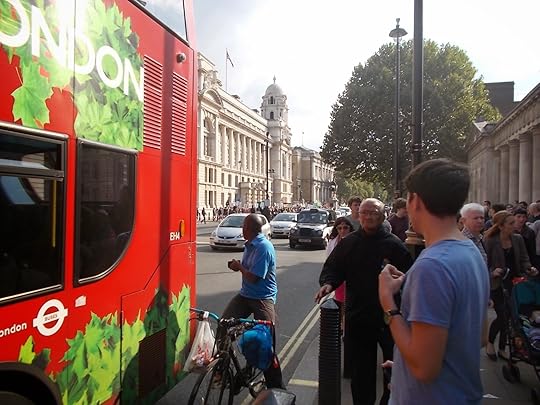
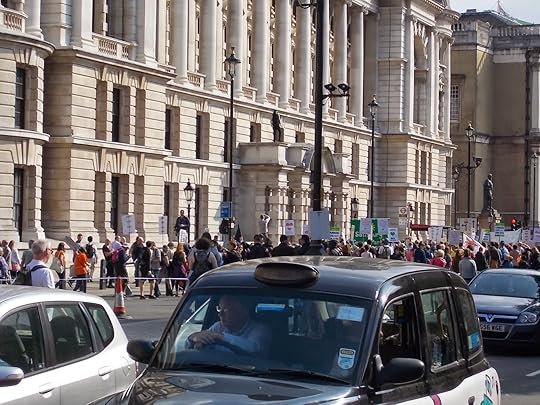
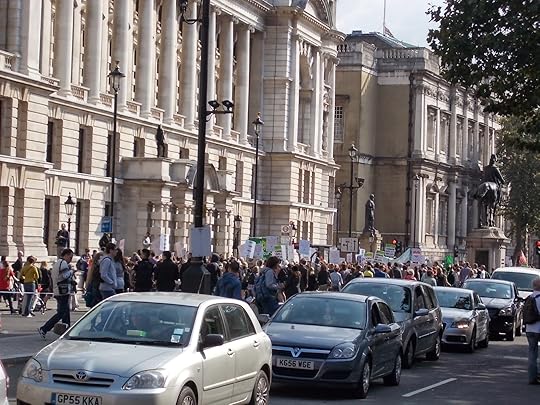
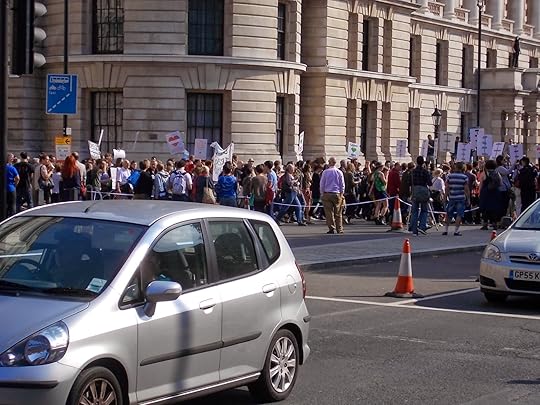
In time, they made their way down to The Clarence, where we were seated.
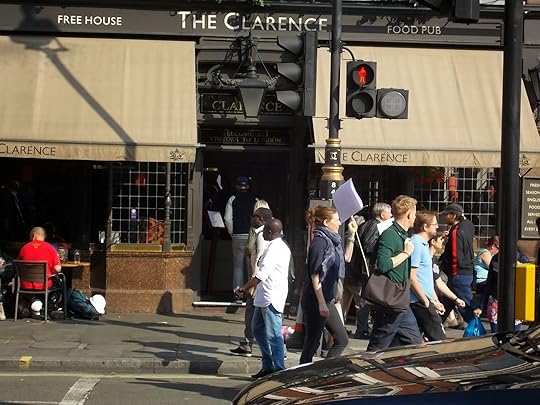
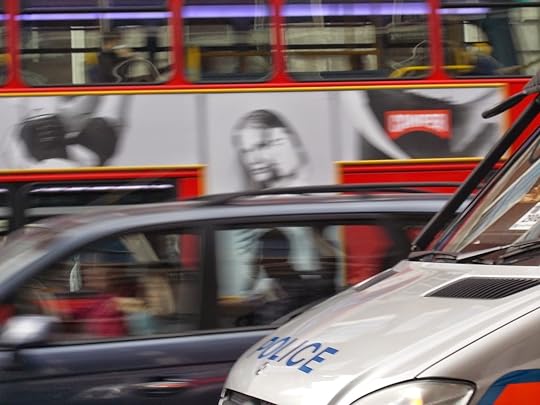
And that's when the police van pulled up right in front of our table.

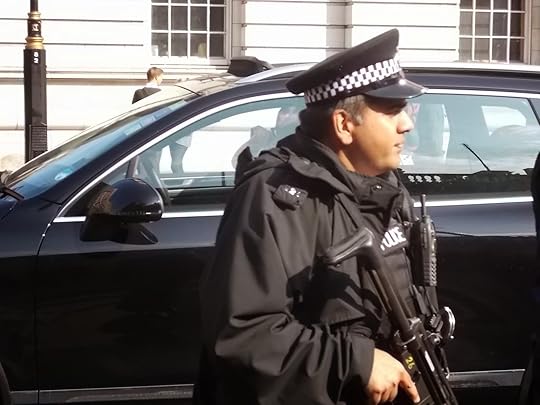
We took it as our cue to leave once the armed cops jumped out of the rear of the van and took up positions pretty much right in front of our table. Even though we were forced to beat a rather hasty retreat towards Trafalgar Square in the opposite direction, we still say that it is worth scheduling your next London visit around the open dates. You'll have opportunities to visit buildings otherwise never open to the likes of us -- or only available at high prices. For more information, click here. More visits in upcoming posts, sans law enforcement.
It was a warm day...and crowds filled the pavements in order to visit buildings during Open House London, a real treat, during which public and private structures that are usually closed to the public freely welcome visitors on a weekend each autumn. Join us now as we break for reviving cocktails at a sidewalk table at The Clarence in Whitehall, diagonally opposite Horseguards.






To say that sitting outside the Clarence puts one in the thick of things is a bit of an understatement, as these photos demonstrate. However, it's a grand place from which to people watch and we enjoyed the break - until a mob of protestors arrived en masse, as you can see in the photo below. Unfortunately, neither of us can remember what they were protesting.




In time, they made their way down to The Clarence, where we were seated.


And that's when the police van pulled up right in front of our table.


We took it as our cue to leave once the armed cops jumped out of the rear of the van and took up positions pretty much right in front of our table. Even though we were forced to beat a rather hasty retreat towards Trafalgar Square in the opposite direction, we still say that it is worth scheduling your next London visit around the open dates. You'll have opportunities to visit buildings otherwise never open to the likes of us -- or only available at high prices. For more information, click here. More visits in upcoming posts, sans law enforcement.
Published on June 06, 2016 00:00
June 3, 2016
OPEN HOUSE 2014: THE BANQUETING HOUSE
OPEN HOUSE 2014: THE BANQUETING HOUSE
Almost immediately across Whitehall from Horse Guards stands the elegant Banqueting House by architect Inigo Jones, completed in 1622, influenced by the classical buildings created by Andrea Palladio and Renaissance styles in Italy. Jones had traveled and studied there, and he was an innovator, the first to adapt Palladian styles in Britain. The building was used for grand occasions: feasts, theatrical masques, and celebrations. For more about Palladian architecture in Britain, click here.
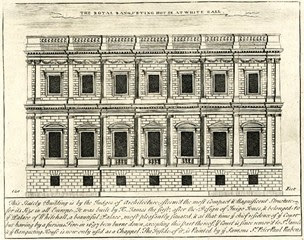 Drawing of the building
Drawing of the building
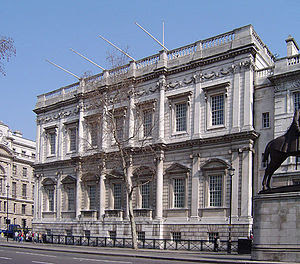 The Banqueting House, Whitehall
The Banqueting House, Whitehall
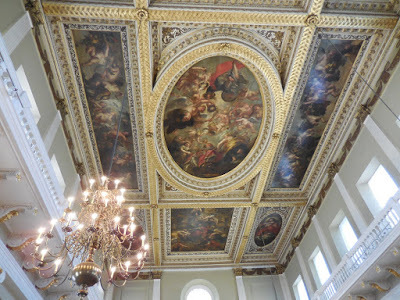 The magnificent ceiling paintings are the work of Sir Peter Paul Rubens, who completed them in 1636.
The magnificent ceiling paintings are the work of Sir Peter Paul Rubens, who completed them in 1636.
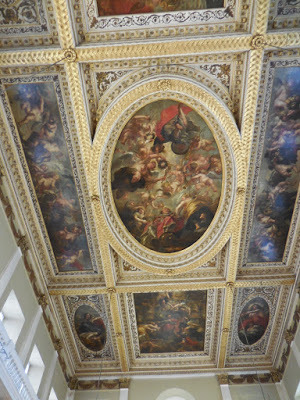 At the center, is The Apotheosis of James Icommissioned by his son, King Charles I.
At the center, is The Apotheosis of James Icommissioned by his son, King Charles I.
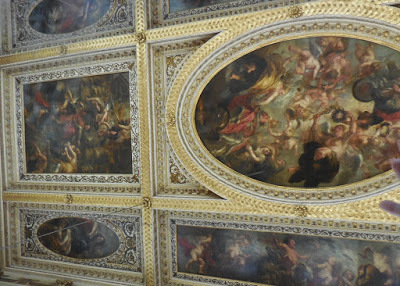
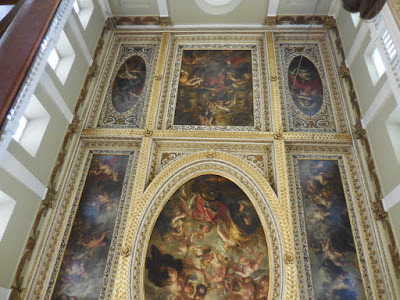 These are the only ceiling paintings by Rubens still in their original placement.
These are the only ceiling paintings by Rubens still in their original placement.
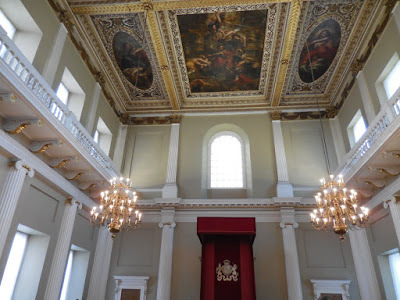 The main room is a double cube, mathematically precise as these17th century ideal structures were.
The main room is a double cube, mathematically precise as these17th century ideal structures were.
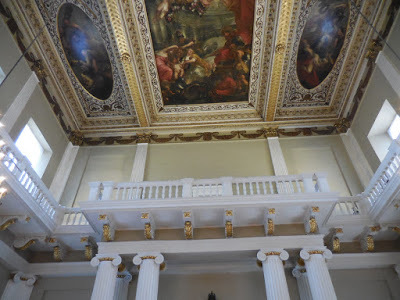 Charles I was beheaded outside the Banqueting House in 1649 after the Civil War.His son Charles II was returned to the throne in the Restoration of 1660.
Charles I was beheaded outside the Banqueting House in 1649 after the Civil War.His son Charles II was returned to the throne in the Restoration of 1660.
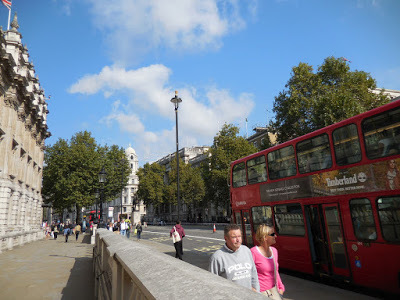 Whitehall
Whitehall
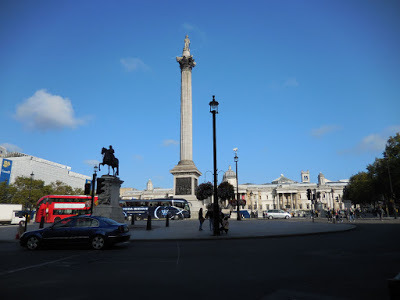 At the top of Whitehall is Trafalgar Square; A statue of Charles I stands at the head of the street.
At the top of Whitehall is Trafalgar Square; A statue of Charles I stands at the head of the street.
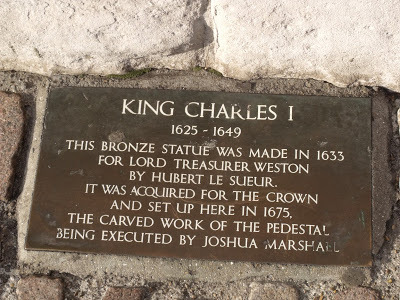
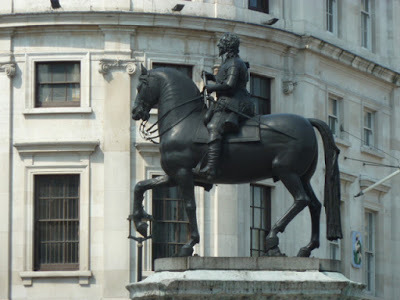 Charles I (1600-1649)
Charles I (1600-1649)
Almost immediately across Whitehall from Horse Guards stands the elegant Banqueting House by architect Inigo Jones, completed in 1622, influenced by the classical buildings created by Andrea Palladio and Renaissance styles in Italy. Jones had traveled and studied there, and he was an innovator, the first to adapt Palladian styles in Britain. The building was used for grand occasions: feasts, theatrical masques, and celebrations. For more about Palladian architecture in Britain, click here.
 Drawing of the building
Drawing of the building The Banqueting House, Whitehall
The Banqueting House, Whitehall The magnificent ceiling paintings are the work of Sir Peter Paul Rubens, who completed them in 1636.
The magnificent ceiling paintings are the work of Sir Peter Paul Rubens, who completed them in 1636. At the center, is The Apotheosis of James Icommissioned by his son, King Charles I.
At the center, is The Apotheosis of James Icommissioned by his son, King Charles I.
 These are the only ceiling paintings by Rubens still in their original placement.
These are the only ceiling paintings by Rubens still in their original placement. The main room is a double cube, mathematically precise as these17th century ideal structures were.
The main room is a double cube, mathematically precise as these17th century ideal structures were. Charles I was beheaded outside the Banqueting House in 1649 after the Civil War.His son Charles II was returned to the throne in the Restoration of 1660.
Charles I was beheaded outside the Banqueting House in 1649 after the Civil War.His son Charles II was returned to the throne in the Restoration of 1660. Whitehall
Whitehall At the top of Whitehall is Trafalgar Square; A statue of Charles I stands at the head of the street.
At the top of Whitehall is Trafalgar Square; A statue of Charles I stands at the head of the street.
 Charles I (1600-1649)
Charles I (1600-1649)
Published on June 03, 2016 00:00
May 31, 2016
A TOUR GUIDE IN ENGLAND: BOOKS KRISTINE SAW ALONG THE WAY
Having just returned from England on Number One London Tour business, I can tell you that great things are in store - stay tuned for complete details of the tours we'll be offering in Spring/Summer/Fall 2017. In the meantime, I thought I'd share with you a few of the interesting book titles I saw along the way. Click on the text links for more info on each title.
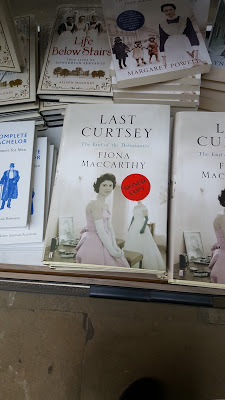
The Last Curtsey
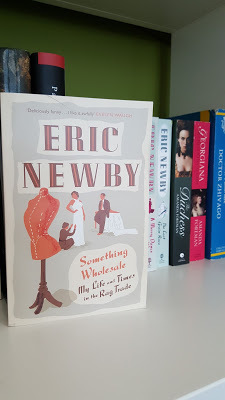
Something Wholesale
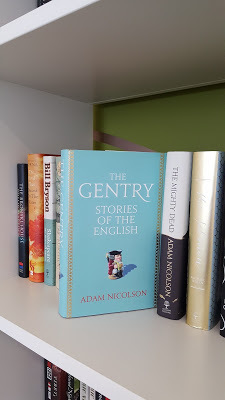
The Gentry: Stories of the English
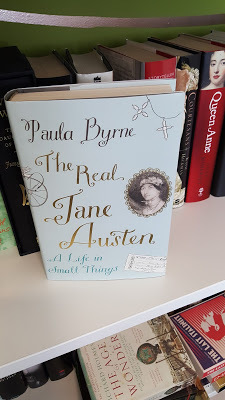
The Real Jane Austen
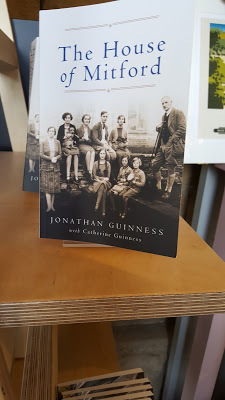
The House of Mitford
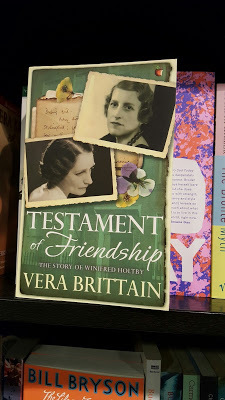
Testament of Friendship
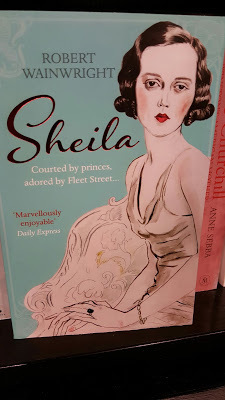
Sheila
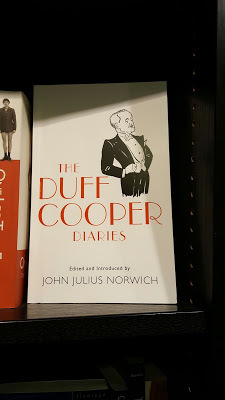
The Duff Cooper Diaries
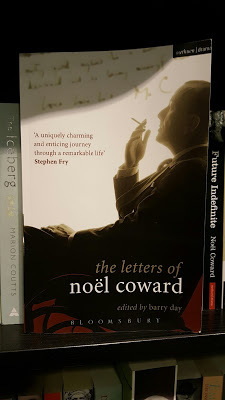
The Letters of Noel Coward
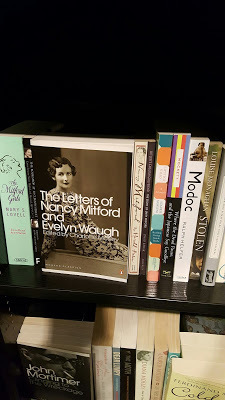
The Letters of Nancy Mitford and Evelyn Waugh
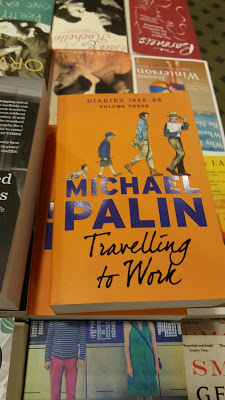
Travelling to Work
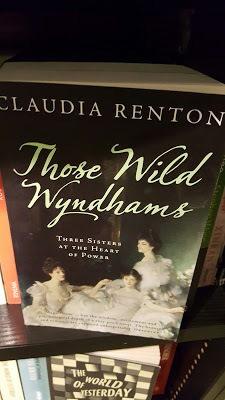
Those Wild Wyndhams
Published on May 31, 2016 23:30
May 30, 2016
THE HORSE GUARDS OPEN HOUSE DAY
One of the places Victoria and I were most anxious to visit on Open Houses Day in London was Horseguards. As you all know, neither Victoria nor I are strangers to Horseguards, but Open Houses Day presented a unique opportunity for us to finally see the Duke of Wellington's office and desk, both of which are pretty much untouched since the Duke's departure, though still used by the commanders through the years.
As you can see by the photos below, it was glorious day, so Victoria and I decided to walk to Horseguards from Trafalgar Square.
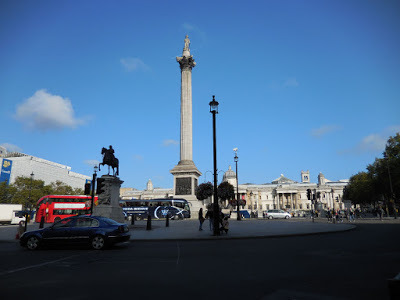
Looking South on Whitehall, Horse Guards is coming up on the right.
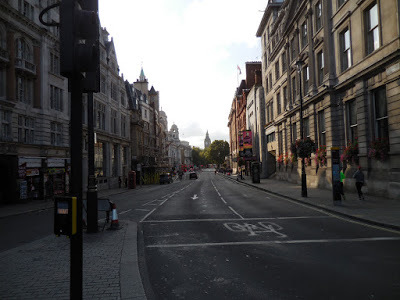
Approaching Horse Guards: Big Ben in the Distance
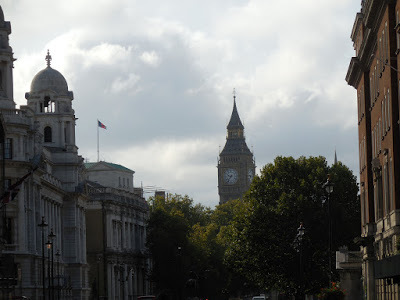
Upon arrival at Horse Guards, we found that there was a bit of line to get in. Normally, we would have grumbled at the wait, but heck, when one is treated to a review and change of guards during the wait one would be an idiot to complain.
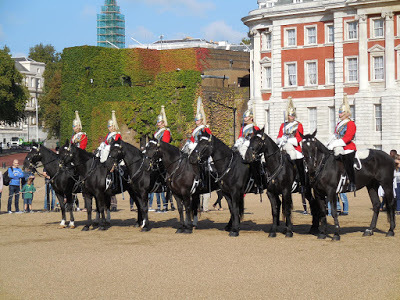
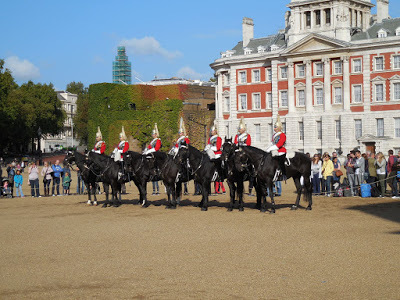
The Life Guards above, and the Blues and Royals below.
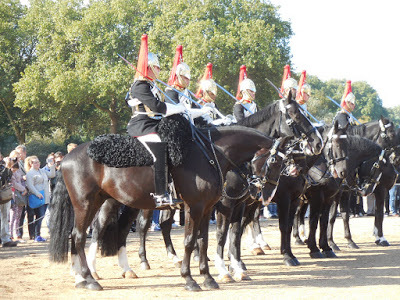
As it turned out Horse Guards was overwhelmed by the number of people who had turned out for tours of the building, so a young soldier in fatigues was handed a few sheets of historical notes and told to have at it. Thus, our tour began.
One of our first stops was the Cock pit, located below the stables.
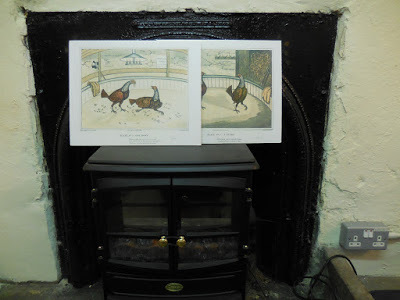
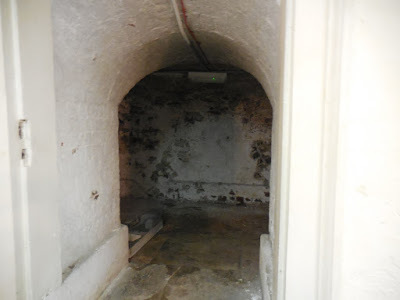
Once our group was assembled within the confined space, our guide read from his notes, telling us about the history of cock fighting at Horse Guards - and how Wellington had allowed it to continue while serving as Commander in Chief of the Army.
"Ridiculous. Wellington would never have countenanced such a thing!" Had I just said that aloud? Apparently I had.
Our guide looked down at the notes in his hand. "But it says so right here," he protested valiantly.
"I don't doubt it. However I'm telling you that it's rubbish. The Duke served as Commander in Chief of the Army from 1842 to 1852. Cock fighting had been banned in England well before that time (Cruelty to Animals Act 1835) and Wellington would not have flaunted the law, nor allowed his men to do so."
Victoria laid a calming hand upon my arm. Oh, Lud, I thought, I have become that old woman. You know, the one who goes about correcting strangers and sticking her nose in where it don't belong. For several years now, I have been known as the Wellington woman in various quarters. I had just elevated myself to the old Wellington woman. Sigh.
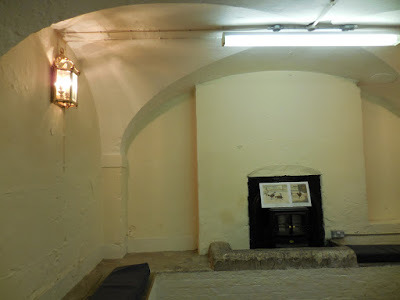
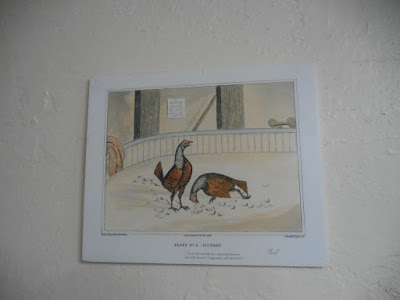
Eventually, we made our way upstairs.
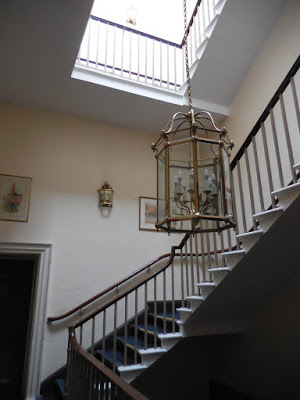 Stairs to the first floor
Stairs to the first floor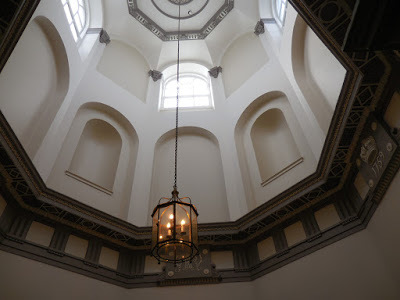 Looking above
Looking above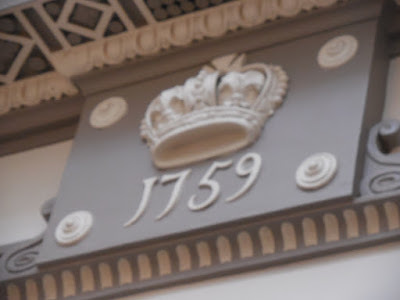
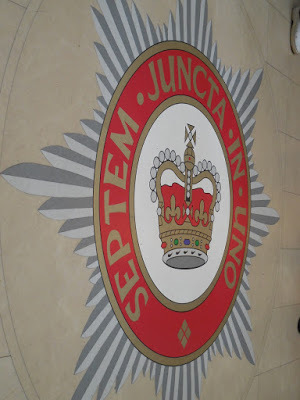
In the Floor: Seven Joined in One, referring to seven regiments of Household Division --The Life Guards, Blues and Royals, Welsh Guards, Grenadier Guards, Scots Guards, Coldstream Guards, Irish Guards.
Each regiment has its own ceremonial drum.
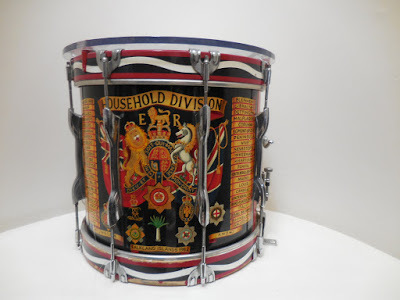
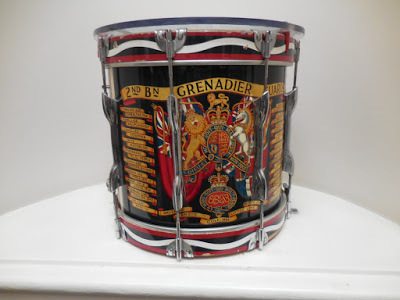
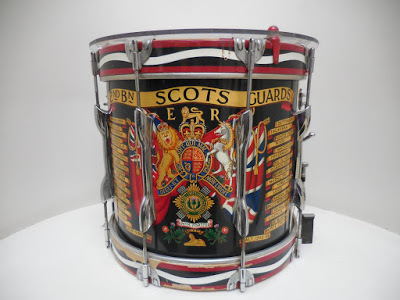
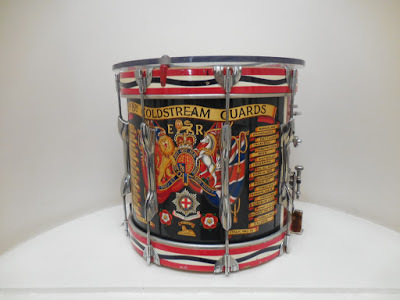
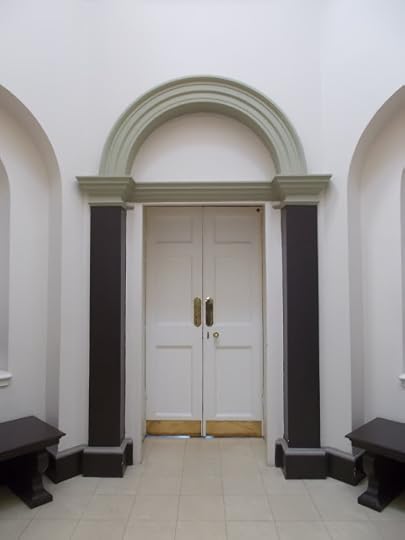
And then, before our very eyes was the entrance to the Duke of Wellington's office, wherein lies his desk.
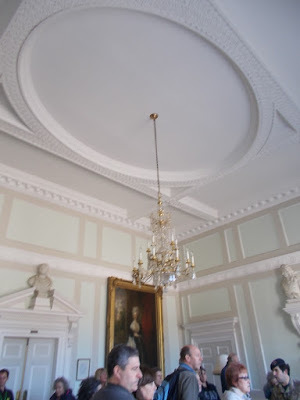
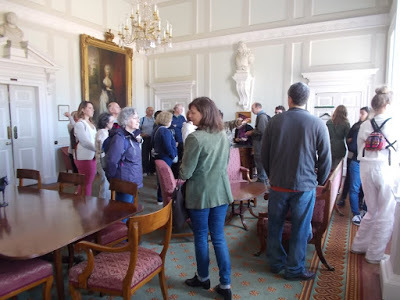
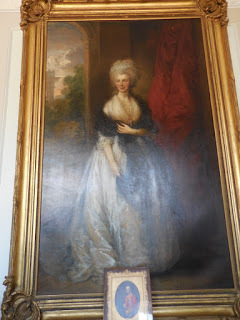 Portrait of Queen Charlotte
Portrait of Queen Charlotte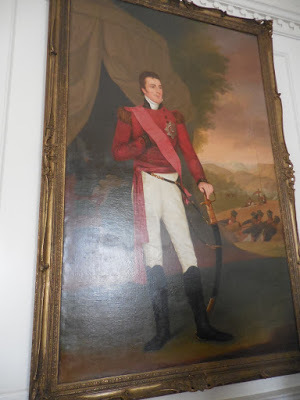
Arthur Wellesley, 1st Duke of Wellington
View from the Duke's office of the forecourt and Whitehall
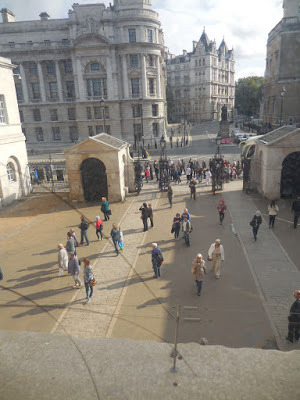
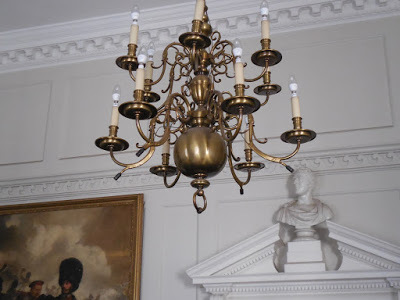
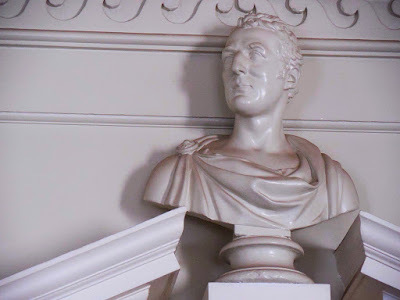
Once we were all in the room, our guide read from his notes and told us, "And above the door is a bust of Lord Palmerston."
"Palmerston? That's the Duke of Wellington," Victoria said aloud.
"Look," said our guide, turning his notes so that Victoria could see them, "it says Lord Palmerston."
"I see that," Victoria agreed, " but I can assure you that it's Wellington. She looked at me, "Isn't it?"
I had decided not to say anything else on the subject after my outburst in the cock pit. After all, the majority of the people in the room with us wouldn't know Wellington from Churchill if push came to shove. Nevermind Palmerston. Put on the spot now, I had to admit, in front of many pairs of staring eyes, that the bust was indeed that of Wellington. We moved on.
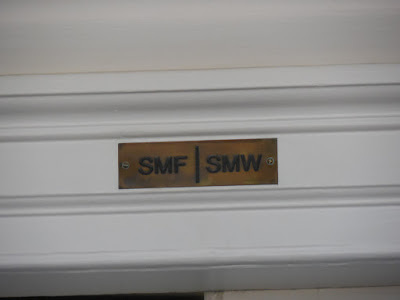
The dividing line between the parishes of St. Martin in the Fields and St. Margaret's Westminster passes through the Horse Guards Building.
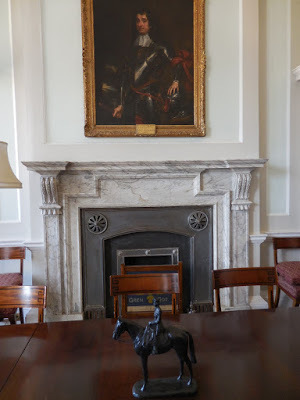
The Duke's office fireplace
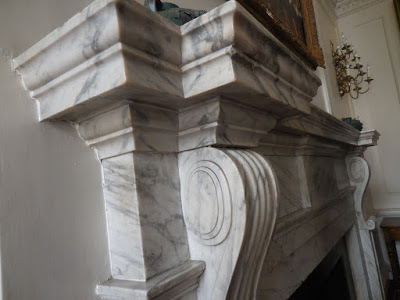
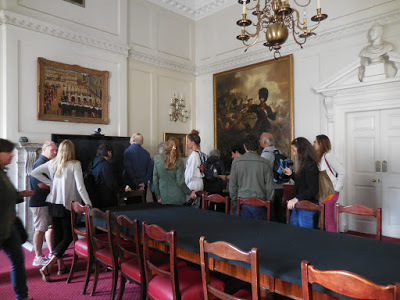
In the Duke's Office, above and below, our fellow attendees
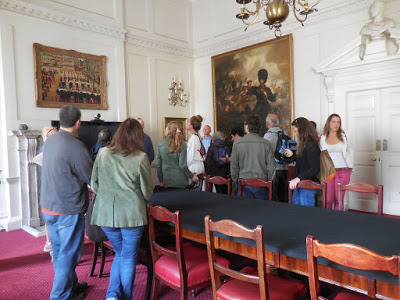
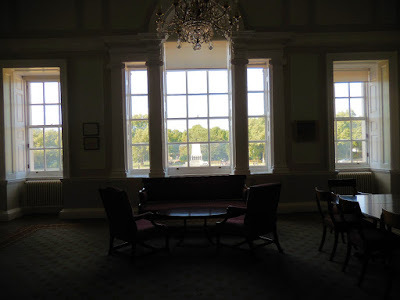
The office window overlooking the parade grounds.
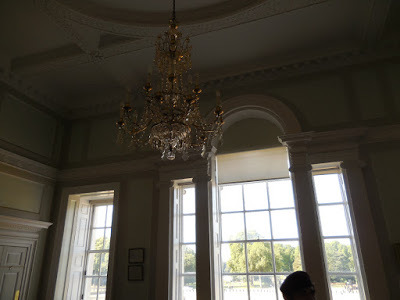
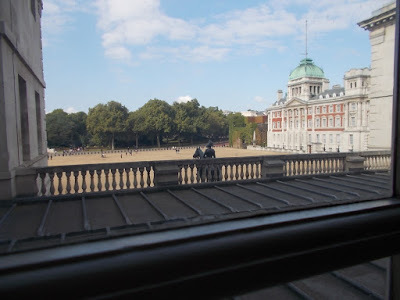
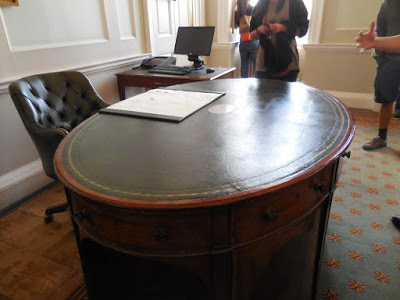
And last, but certainly not least, the Duke's desk.
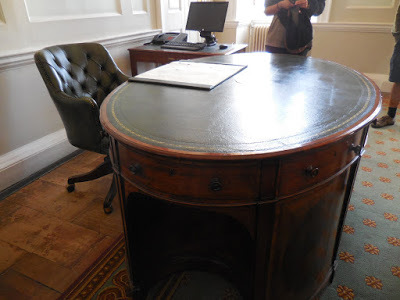
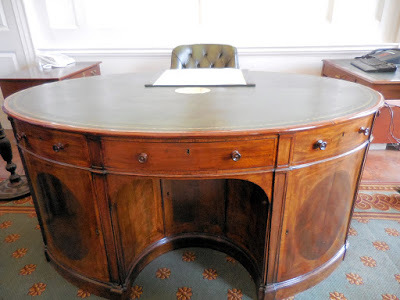
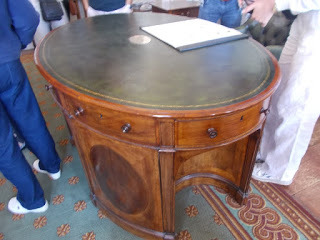
You can find a complete history of this desk and its origins in this article by retired Major Ian Mattison on the Waterloo 200 website.
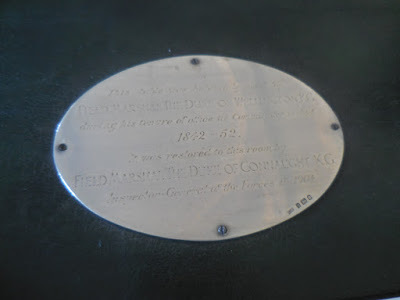
The plaque reads, "This table was habitually used by Field Marshal The Duke of Wellington K.G. during his tenure as Commander in Chief 1842-52. It was restored to this room by Field Marshal The Duke of Connaught, Inspector General of the Forces 1904."
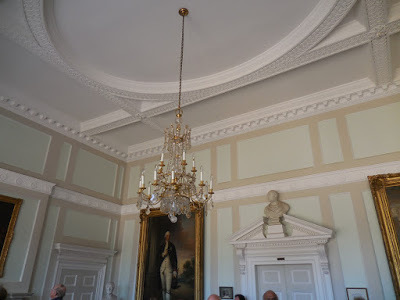 In the background, a portrait of George III
In the background, a portrait of George III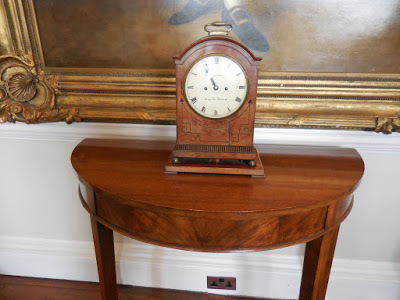
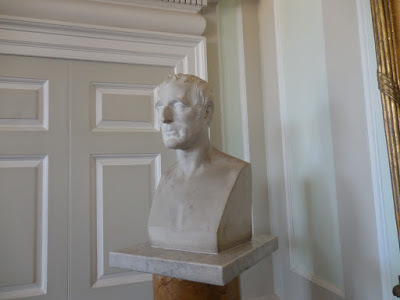
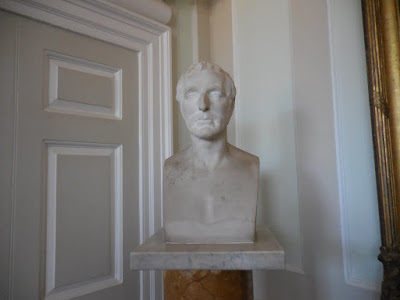

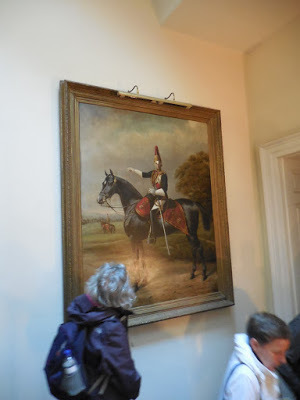
At the end of the tour, we left by a set of backstairs -
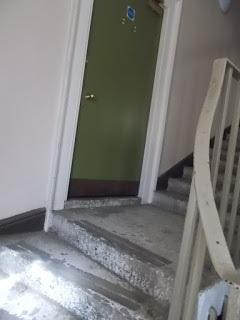
which provided a unique perspective of one of the guards on duty.
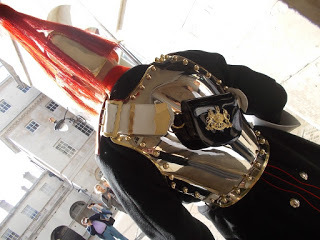
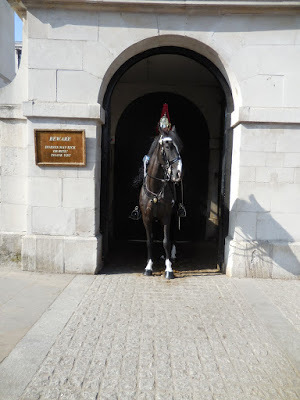
Published on May 30, 2016 00:30
Kristine Hughes's Blog
- Kristine Hughes's profile
- 6 followers
Kristine Hughes isn't a Goodreads Author
(yet),
but they
do have a blog,
so here are some recent posts imported from
their feed.
























